Motorola Solutions 89FT5794 iDEN i2000 User Manual
Motorola Solutions, Inc. iDEN i2000
Contents
- 1. User Manual
- 2. User manual
User Manual
Motorola
TM
iDEN
®
Digital Multi-Service
i
2000 User’s Guide
Draft Two
5/6/99 FCC ID: AZ489FT5794

i
Contents
CONTENTS
Getting Started . . . . . . . . . . . . . . . . . . . . . . . . . . . . . . . . . 1
Setting Up Your
i
2000 for Use . . . . . . . . . . . . . . . . . . . . . . . . . . .1
Features of Your
i
2000 . . . . . . . . . . . . . . . . . . . . . . . . . . . . . . . . . .2
Inserting the SIM Card . . . . . . . . . . . . . . . . . . . . . . . . . . . . . . . . . .4
Charging and Attaching the Battery . . . . . . . . . . . . . . . . . . . . . . . .5
Turning On Your
i
2000 . . . . . . . . . . . . . . . . . . . . . . . . . . . . . . . . .6
SIM Card PIN . . . . . . . . . . . . . . . . . . . . . . . . . . . . . . . . . . . . . . . . . 7
Entering the PIN . . . . . . . . . . . . . . . . . . . . . . . . . . . . . . . . . . . 7
Unblocking the PIN . . . . . . . . . . . . . . . . . . . . . . . . . . . . . . . .7
Changing the PIN . . . . . . . . . . . . . . . . . . . . . . . . . . . . . . . . . . 8
Disabling the PIN Requirement . . . . . . . . . . . . . . . . . . . . . . .8
Enabling the PIN Requirement . . . . . . . . . . . . . . . . . . . . . . . . 9
Display Icons . . . . . . . . . . . . . . . . . . . . . . . . . . . . . . . . . . . . . . . .10
About Modes and Menus . . . . . . . . . . . . . . . . . . . . . . . . . . . . . . .11
About Modes and Menus . . . . . . . . . . . . . . . . . . . . . . . . . . . . . . .11
Setting the Time and Date . . . . . . . . . . . . . . . . . . . . . . . . . . . . . .12
Changing the Display Language . . . . . . . . . . . . . . . . . . . . . . . . . 13
Making Phone Calls . . . . . . . . . . . . . . . . . . . . . . . . . . . . 15
International Phone Calls . . . . . . . . . . . . . . . . . . . . . . . . . . .15
Inserting Pauses into Phone Numbers . . . . . . . . . . . . . . . . . . 15
Using Other Dialing Methods . . . . . . . . . . . . . . . . . . . . . . . . . . . 15
Emergency Dial . . . . . . . . . . . . . . . . . . . . . . . . . . . . . . . . . . .16
Automatic Redial . . . . . . . . . . . . . . . . . . . . . . . . . . . . . . . . . 17
Last Number Redial . . . . . . . . . . . . . . . . . . . . . . . . . . . . . . . 17
Turbo Dial® . . . . . . . . . . . . . . . . . . . . . . . . . . . . . . . . . . . . . 17
Hands-Free Speakerphone . . . . . . . . . . . . . . . . . . . . . . . . . . . . . . 17
Receiving a Phone Call . . . . . . . . . . . . . . . . . . . . . . . . . . . . . . . . 18
Missed Call Indicator . . . . . . . . . . . . . . . . . . . . . . . . . . . . . . . . . . 18
What Is My Phone Number? . . . . . . . . . . . . . . . . . . . . . . . . . . . . 19
VibraCall™ . . . . . . . . . . . . . . . . . . . . . . . . . . . . . . . . . . . . . . . . . 19
Selecting VibraCall for All Incoming Calls and Messages . 20
Selecting VibraCall for Individual Services . . . . . . . . . . . . . 20
Setting the Ringer Volume . . . . . . . . . . . . . . . . . . . . . . . . . . . . . . 21
Selecting a Ring Style . . . . . . . . . . . . . . . . . . . . . . . . . . . . . . . . . 21
Call Forwarding . . . . . . . . . . . . . . . . . . . . . . . . . . . . . . . . . . . . . . 22
Unconditional Call Forwarding . . . . . . . . . . . . . . . . . . . . . .22
Conditional Call Forwarding . . . . . . . . . . . . . . . . . . . . . . . .23
Call Waiting . . . . . . . . . . . . . . . . . . . . . . . . . . . . . . . . . . . . . . . . .24
Call Hold . . . . . . . . . . . . . . . . . . . . . . . . . . . . . . . . . . . . . . . . . . . 24
3-Way Calling . . . . . . . . . . . . . . . . . . . . . . . . . . . . . . . . . . . . . . . 24

ii
i2000 User’s Guide
Call Barring . . . . . . . . . . . . . . . . . . . . . . . . . . . . . . . . . . . . . . . . .25
Barring Incoming Calls . . . . . . . . . . . . . . . . . . . . . . . . . . . . . 25
Barring Outgoing Calls . . . . . . . . . . . . . . . . . . . . . . . . . . . . .25
Viewing Call Barring Status . . . . . . . . . . . . . . . . . . . . . . . . . 26
Changing Your Call Barring Passcode . . . . . . . . . . . . . . . . . 27
Alternate Phone Line (iDEN Only) . . . . . . . . . . . . . . . . . . . . . . . 28
Setting the Active Line . . . . . . . . . . . . . . . . . . . . . . . . . . . . .28
Receiving a Call . . . . . . . . . . . . . . . . . . . . . . . . . . . . . . . . . .28
Receiving a Call on Your Alternate Line . . . . . . . . . . . . . . .29
Phone Only Mode (iDEN Only) . . . . . . . . . . . . . . . . . . . . . . . . . . 29
Traveling between Systems . . . . . . . . . . . . . . . . . . . . . . 31
Searching for a Network . . . . . . . . . . . . . . . . . . . . . . . . . . . .31
Storing Your Preferred List of Networks . . . . . . . . . . . . . . . 32
Creating, Editing, and Using Stored Lists . . . . . . . . . . . . . . . . . .33
Combined Phone Number and Private ID List . . . . . . . . . . . 33
Last 10 Calls Received and Sent Lists . . . . . . . . . . . . . . . . .36
Quickstore of Phone Numbers . . . . . . . . . . . . . . . . . . . . . . .37
Making Private Calls . . . . . . . . . . . . . . . . . . . . . . . . . . . 39
Receiving a Private Call . . . . . . . . . . . . . . . . . . . . . . . . . . . . . . . .40
Private/Group Mode Speaker . . . . . . . . . . . . . . . . . . . . . . . . . . . .40
Call Alert™ . . . . . . . . . . . . . . . . . . . . . . . . . . . . . . . . . . . . . . . . . 40
Sending a Call Alert . . . . . . . . . . . . . . . . . . . . . . . . . . . . . . . 40
Receiving a Call Alert . . . . . . . . . . . . . . . . . . . . . . . . . . . . . . 41
Call Alert Queuing . . . . . . . . . . . . . . . . . . . . . . . . . . . . . . . .41
Clearing or Queueing a Call Alert . . . . . . . . . . . . . . . . . . . . 41
Responding to a Queued Call Alert . . . . . . . . . . . . . . . . . . . 41
Quickstore of Private IDs . . . . . . . . . . . . . . . . . . . . . . . . . . . . . . . 41
Storing Your Private ID . . . . . . . . . . . . . . . . . . . . . . . . . . . . . . . . 42
Making Group Calls (Iden only) . . . . . . . . . . . . . . . . . 43
Receiving a Group Call . . . . . . . . . . . . . . . . . . . . . . . . . . . . . . . .43
Adding and Storing a Talkgroup . . . . . . . . . . . . . . . . . . . . . . . . .44
Area Selection . . . . . . . . . . . . . . . . . . . . . . . . . . . . . . . . . . . . . . . 44
Private/Group Mode Speaker . . . . . . . . . . . . . . . . . . . . . . . . . . . .44
Using Mail Services . . . . . . . . . . . . . . . . . . . . . . . . . . . . 45
Voice Mail . . . . . . . . . . . . . . . . . . . . . . . . . . . . . . . . . . . . . . . . . .45
Message Mail . . . . . . . . . . . . . . . . . . . . . . . . . . . . . . . . . . . . . . . .46
Saving and Erasing Mail . . . . . . . . . . . . . . . . . . . . . . . . . . . .46
Auto Call Back . . . . . . . . . . . . . . . . . . . . . . . . . . . . . . . . . . . 47
Mail Memory Full . . . . . . . . . . . . . . . . . . . . . . . . . . . . . . . . . 47

iii
Contents
Setting Programming Menus . . . . . . . . . . . . . . . . . . . . 48
About Status Messages . . . . . . . . . . . . . . . . . . . . . . . . . 53
Accessories . . . . . . . . . . . . . . . . . . . . . . . . . . . . . . . . . . . 55
Batteries . . . . . . . . . . . . . . . . . . . . . . . . . . . . . . . . . . . . . . . . . .55
Charging the Batteries . . . . . . . . . . . . . . . . . . . . . . . . . . . . . . 55
Battery Operating Instructions . . . . . . . . . . . . . . . . . . . . . . . 55
Travel Charger . . . . . . . . . . . . . . . . . . . . . . . . . . . . . . . . . . . . . . . 56
Using the Travel Charger . . . . . . . . . . . . . . . . . . . . . . . . . . . 56
Travel Charger Operating Specifications . . . . . . . . . . . . . . . 56
Vehicular Battery Charger . . . . . . . . . . . . . . . . . . . . . . . . . . . . . .56
Using the Vehicular Battery Charger . . . . . . . . . . . . . . . . . . 57
Removing the Vehicular Battery Charger . . . . . . . . . . . . . . . 57
Vehicular Battery Charger Operating Specifications . . . . . .57
Desktop Dual-Pocket Charger . . . . . . . . . . . . . . . . . . . . . . . . . . . 58
Charging a Battery . . . . . . . . . . . . . . . . . . . . . . . . . . . . . . . . 58
Audio Adapter . . . . . . . . . . . . . . . . . . . . . . . . . . . . . . . . . . . . . . .59
Using the Audio Adapter . . . . . . . . . . . . . . . . . . . . . . . . . . . 59
Attaching/Detaching the Earpiece Microphone . . . . . . . . . . 59
Removing the Audio Adapter . . . . . . . . . . . . . . . . . . . . . . . 59
For the Safe and Efficient Operation of Your Radio, Observe these Guidelines:
60
Exposure To Radio Frequency Energy . . . . . . . . . . . . . . . . . . . . 60
Safety and General Information . . . . . . . . . . . . . . . . . . 60
Interference to Medical and Personal Electronic Devices . . . . . .61
Pacemakers . . . . . . . . . . . . . . . . . . . . . . . . . . . . . . . . . . . . . . . . . .61
Hearing Aids . . . . . . . . . . . . . . . . . . . . . . . . . . . . . . . . . . . . . . . .61
Other Medical Devices . . . . . . . . . . . . . . . . . . . . . . . . . . . . . . . . .62
Interference to Other Electronic Devices . . . . . . . . . . . . . . . 62
Safety and General . . . . . . . . . . . . . . . . . . . . . . . . . . . . . . . . . . . . 62
Use While Driving . . . . . . . . . . . . . . . . . . . . . . . . . . . . . . . . 62
OPERATIONAL
WARNINGS . . . . . . . . . . . . . . . . . . . . . . . . . . . . . . . . . . . . . . . .63
Potentially Explosive Atmospheres . . . . . . . . . . . . . . . . . . . 63
Batteries . . . . . . . . . . . . . . . . . . . . . . . . . . . . . . . . . . . . . . . .63
Blasting Caps and Areas . . . . . . . . . . . . . . . . . . . . . . . . . . . . 63
For Vehicles Equipped with an Air Bag . . . . . . . . . . . . . . . .63
OPERATIONAL CAUTIONS . . . . . . . . . . . . . . . . . . . 64

iv
i2000 User’s Guide
Damaged Antennas . . . . . . . . . . . . . . . . . . . . . . . . . . . . . . . . 64
Batteries . . . . . . . . . . . . . . . . . . . . . . . . . . . . . . . . . . . . . . . .64
Cleaning Instructions . . . . . . . . . . . . . . . . . . . . . . . . . . . . . . 64
Antenna Considerations . . . . . . . . . . . . . . . . . . . . . . . . . . . .64
Accessory Safety Information . . . . . . . . . . . . . . . . . . . . 65
Owner’s Information . . . . . . . . . . . . . . . . . . . . . . . . . . . . . . . . . .67
Private Number Directory . . . . . . . . . . . . . . . . . . . . . . . . . . . 68
Talkgroup Directory . . . . . . . . . . . . . . . . . . . . . . . . . . . . . . . 68
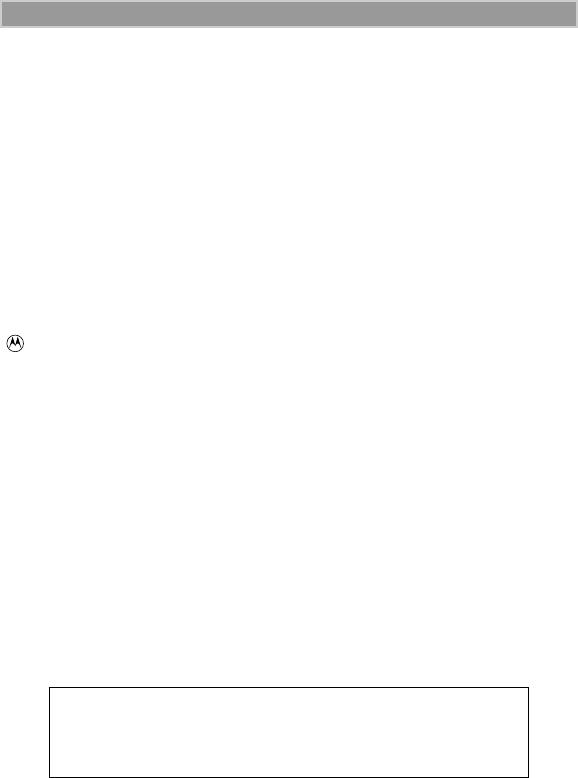
v
i2000 User’s Guide
Patent and Trademark Information
This product is protected under one or more of the following patents:
4817157, 4896361, 4857928, 5041793, 5060294, 5066923, 5134718, 5140156,
5239963, 5257411, 5287387, 5265219, 5289504, 5316168, 5317247, 5338396,
5389927, 5406588, 5424921, 5457376, 5460906, 5551063, 5557079, 5596487,
5615412, 5638403, 5559468, 5469465, 5170413, 5140615, 5519730, 5241544,
5584059, 5574992, 5396656, 5487091, 5533004, 5299199, 5343499, 5369501,
5509031, 5515379, 5528723, 5598417, 5066923, 5241650, 5278833, 5359696,
5548631, 5410632, 5440582, 5457735, 5457818, 5471670, 5477550, 5481537,
5566181, 5229767, 5208804, 5295140, 5381449, 5440590, 5467398, 5490230,
5620242, 5623523, 5655913, 5715240, 5771440, 5854578, 5675281
Additional patents are pending.
, Motorola, iDEN, Turbo Dial, VibraCall, Call Alert, and Message Mail are
trademarks or registered trademarks of Motorola, Inc.
®Reg. U.S. Pat. & Tm. Off.
All other trademarks mentioned in this manual are trademarks of their respective
companies.
© Copyright 1999, Motorola, Inc. All rights reserved.
Important!
Be sure to read “Safety and General Information” on page 60
before using your i1000
plus
.

1
Getting Started
GETTING STARTED
ongratulations on purchasing your Motorola iDEN
i
2000 multi-
service, digital, portable global phone. The use of two state-of-
the-art technologies, iDEN and GSM (Global System for Mobile
communications), provides worldwide services to keep you in constant
touch with your business and personal contacts wherever you travel.
A removable Subscriber Identity Module (SIM) card holds all your
personal information, including secure Personal Identification Numbers
(PINs), names, and phone numbers. Just as you protect your credit and
bank cards with PINs, you can safeguard your SIM card with a PIN.
Exciting new features include a vibration-only key, call barring, and a
missed-call indicator to help provide efficient operation of your
i
2000.
And, new ease-of-dialing features, such as Turbo Dial and the Last Ten
Received and Sent lists, as well as stored names and numbers, help you
to quickly make and return phone calls.
Your
i
2000 offers:
•
Phone Mode
- for cellular phone operation.
See page 15.
•
Private Mode
- for two-way radio use to talk with one person in
your iDEN service area.
See page 39.
•
Group Mode
- for two-way radio use to talk with several people in
your iDEN service area.
See page 43.
•
Messaging Services
- for message and voice mail.
See page 45.
Setting Up Your
i
2000 for Use
Before you can use your new
i
2000, you’ll need to:
1. Insert the SIM card—see page 4.
2. Attach the battery—see page 5.
3. Turn on your
i
2000—see page 6.
4.
Optional:
Enter a PIN for your SIM card—see page 7.
NOTE
• Some features of your
i
2000 are available only in the
iDEN service area, and are indicated as such in this
guide.
• This guide describes the features of the
i
2000 as
they were set up by Motorola. However, your carrier
or your organization may have changed or added
features. For morinformation, check with your carrier
or your organization.
C
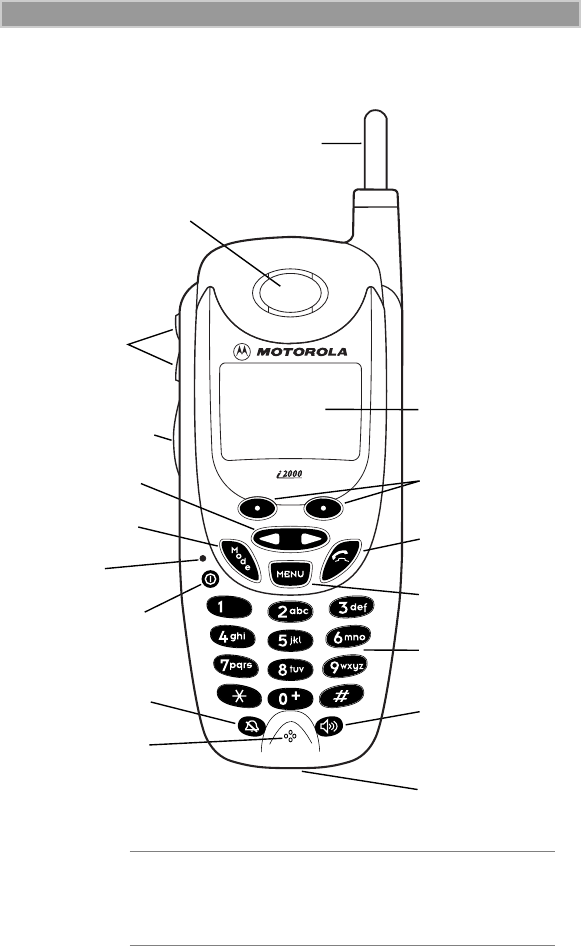
2
i2000 UserÕs Guide
Features of Your
i
2000
NOTE
Before you use your
i
2000 for the first time,
remove the plastic lens protector from the
display.
1. Antenna
12. Option Keys
8. On/Off Key
16. Speaker Key
4. Push-To-Talk
(PTT) Button
3. Volume
Control
Buttons
15. Alphanumeric
Keypad
6. Mode Key
7. LED
14. Menu Key
2. Earpiece
11. Alphanumeric
Display
5. Scroll Key
13. Send/End Key
10. Microphone
17. Accessory
Connector
9. Vibe-all Key
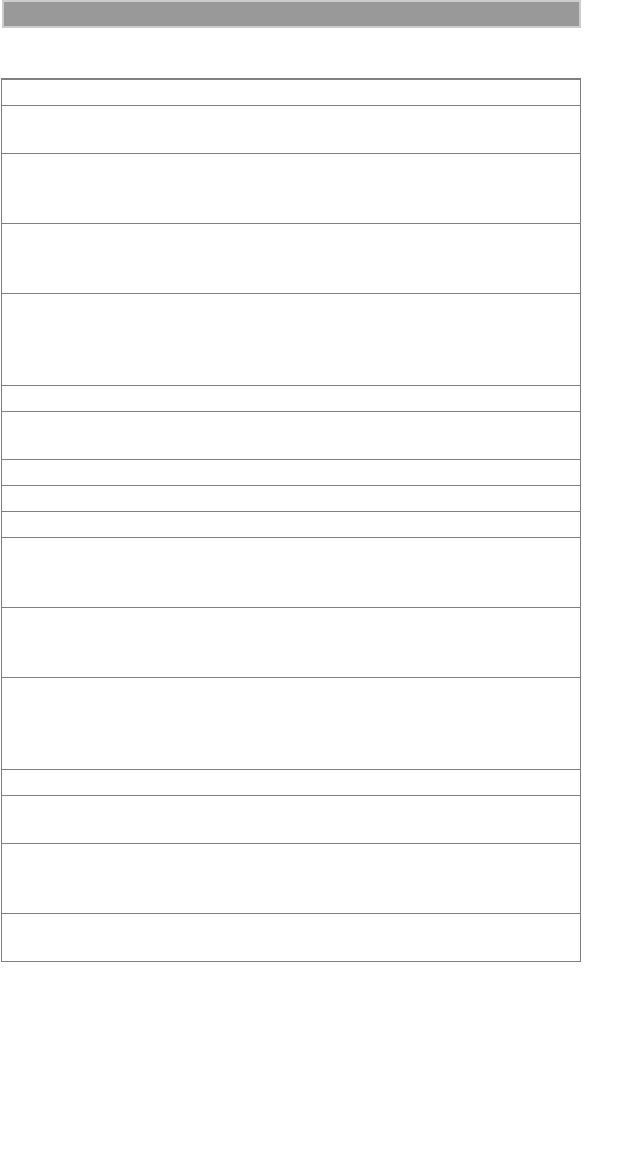
3
Getting Started
1. Antenna Extend for optimal signal.
2 . Earpiece Listen to calls when the speakerphone is
off.
3 . Volume Control
Buttons Press to adjust volume levels in Phone,
Private, and Group modes. In mail menus,
press to scroll forward and backward.
4 . Push-To-Talk
(PTT) Button Transmit a Private or Group Call, or a Call
Alert. Press and hold to talk; release to
listen.
(iDEN use only)
5 . Scroll Key Press the left side to scroll backward or
the right side to scroll forward through
menu options and lists. When entering
text, press to erase text or add a space.
6 . Mode Key Press to change modes.
(iDEN use only)
7 . LED (Light
Emitting Diode) Check the phone’s status. See Table 1 on
page 6 for more information.
8 . On/Off Button Press and hold to turn your
i
2000 on or off.
9 . Vibe-All Key Press to silence or turn on the ringer tone.
1 0 . Microphone Use to speak during calls.
11. Alphanumeric
Display View up to four lines (up to 12 characters
per line) or six lines (up to 16 characters
per line) on the display.
12. Option Keys Press the right or left option key to select
the menu option that appears directly
above the key.
13. Send/End Key Press to answer an incoming Phone call.
After entering a phone number, press to
dial the call or to redial the entered phone
number. Press to end Phone calls.
14. Menu Key Press to scroll through menu options.
15. Alphanumeric
Keypad Enter telephone numbers, Private call IDs,
and alphanumeric characters.
16. Speaker Key Press to switch between the earpiece and
speaker during Private and Group calls.
(iDEN use only)
17. Accessory
Connector Use to connect accessories or the battery
charger.
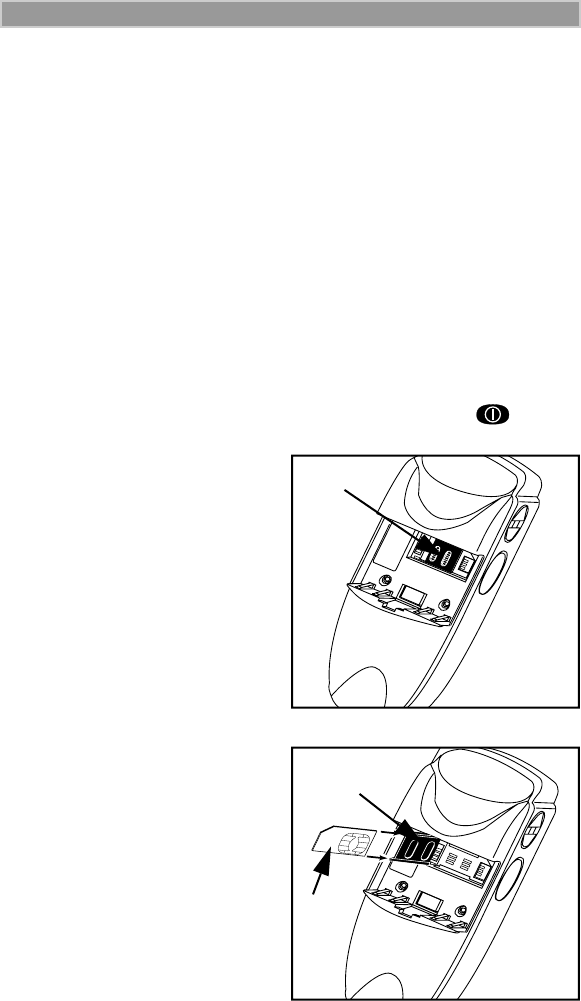
4
i2000 UserÕs Guide
Inserting the SIM Card
The SIM card contains all your stored names, numbers, and PINs after
you enter them in your
i
2000. You can make a phone call only when the
SIM card is properly placed in the phone.
Important!
Insert and remove your SIM card with care so that you do
not lose it.
To insert the SIM card:
1. If your
i
2000 is on, press and hold the On/Off button until
you see the message “Powering Off”.
2. If the battery is attached,
remove it.
For information,
see “Detaching the Battery”
on page 5.
3. Turn the phone over so that
the antenna is at the upper
left corner.
4. Slide the latch to the left
position and open the SIM
card holder.
5. If you have a full-size SIM
card, gently punch out the
mini SIM card.
6. Position the cut corner of the
SIM card as illustrated and
slide the card into the holder.
7. Close the card holder and
slide the latch to the right.
8. Now, you can attach the
battery.
See “Attaching the
Battery” on page 5.
NOTE
Depending on the network that you are on, you
may be able to make an emergency call without
a SIM card.
Latch
Latch
SIM card
holder
SIM
card
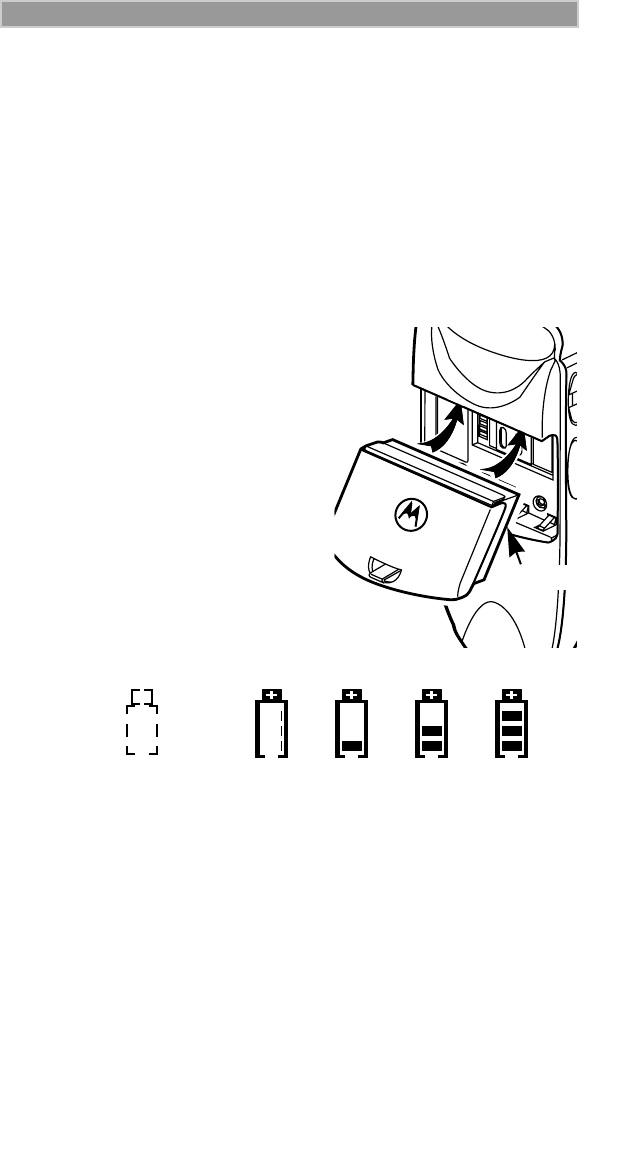
5
Getting Started
Charging and Attaching the Battery
Remove the battery from the protective case provided in the original
packaging. When the battery is not attached to the phone or being
charged, store it in this case.
Charging the Battery
To get the maximum use from the battery, charge it for at least three
hours before you use it for the first time.
Attach the charger connector to the
i
2000, then flip open the prongs and
plug the charger into an electrical outlet.
For more information about
chargers, see “Accessories” on page 55.
Attaching the Battery
To attach the battery to your
i
2000,
align the battery as shown. Press down
on the battery until you hear a click.
Battery and Charging Status
A low battery is indicated by a short,
chirp-like sound through the speaker.
The battery strength icon shows the
remaining charge in the battery. Three
bars indicate full charge. When you
have less than five minutes of talk time
remaining, the indicator flashes.
Figure 1. Battery Charging Status
Detaching the Battery
To detach the battery, press the latch to release the battery and slide the
battery downward.
Icon
Flashes
Charging Low Battery 0-30% 31-60% 61-90% 91-100%
Discharging Low Battery 0-10% 11-40% 41-70% 71-100%
Latch
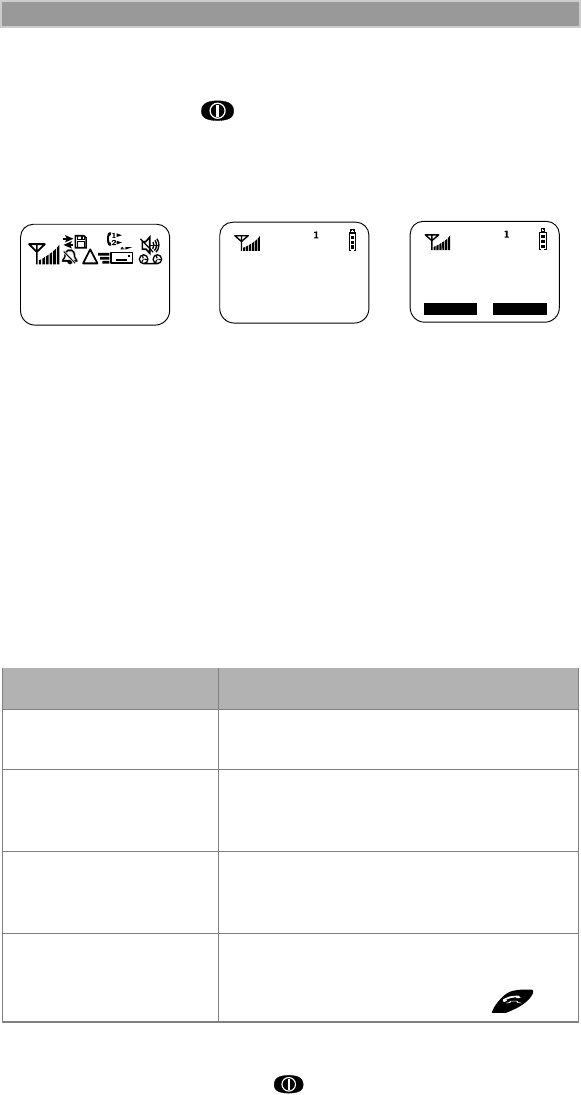
6
i2000 UserÕs Guide
Turning On Your
i
2000
Press the On/Off button until a set of icons appears on your
display.
(For a description of the icons, see page 7.)
Then a message,
such as “Please Wait”, displays while the
i
2000 connects to your
carrier’s network.
First Screen Second Screen Third Screen
The second line of text on the Phone Ready screen, (SystemName)
displays the name of the network providing service in the iDEN or GSM
service area.
When you are on your Home network, the (SystemName) is your
carrier’s name. When you are roaming, the Phone Ready screen displays
the name of the network you are roaming on.
When you are in the iDEN service area, the third line displays the local
time and date. When you are in the GSM service area, the third line
displays the name of your carrier.
The LED indicator located on top of the
i
2000 shows the service state.
See Table 1 .
Table 1: Status LIght (LED) Indicator
Turning Off Your
i
2000
Press and hold the On/Off button until you see the message
“Powering Off”.
LED Indicator Status of Your
i
2000
Flashing Red Registering—your
i
2000 is signing on to
your carrier’s network. Please wait.
Solid Red No service—your
i
2000 cannot sign on.
It will continue trying to connect every
two minutes as long as it is turned on.
Flashing Green In service—your
i
2000 is ready to use.
You can now place and receive calls and
use the browser.
Solid Green In use—-your
i
2000 is currently being
used. Check to make sure that you
ended the last call by pressing .
(Your Carrier
(888)
555-1212
Message) Phone Ready
(SystemName)
1035a 10/03
Name Mail
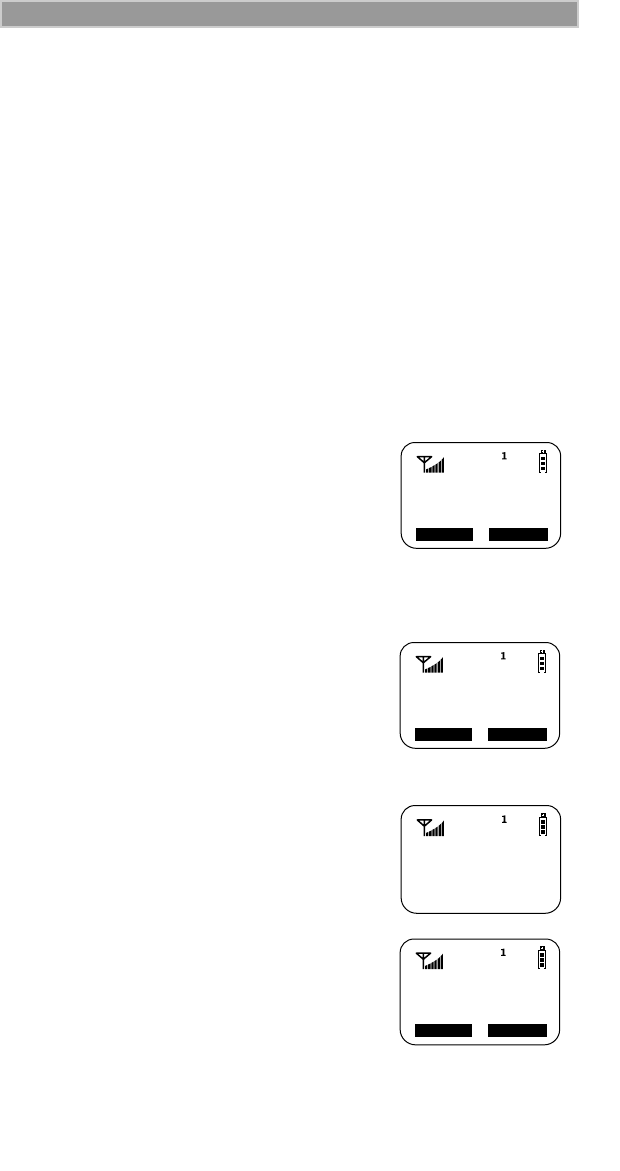
7
Getting Started
SIM Card PIN
To prevent unauthorized use of your phone, you may set a SIM card PIN.
After the PIN is set, each time the
i
2000 is turned on, a PIN must be entered.
After you set a pin, you can later change or disable it.
If your
i
2000 requires a SIM PIN, follow the steps in “Entering the PIN”
on page 7.
If your
i
2000 does not require a PIN and you wish to set one, follow the
steps in “Enabling the PIN Requirement” on page 9.
Entering the PIN
1. Enter your PIN.
As you enter it, an
asterisk appears for each character. This
prevents others from seeing your PIN.
If you enter an incorrect PIN, the
message, ÒWrong PINÓ appears. After
three incorrect attempts, even if you turn
off the phone and turn it on again, the
SIM card PIN is blocked. If this happens,
see "Unblocking the PIN", below.
2. Select “OK”. Now you are ready to place
calls or check your mail.
You can disable the PIN entry requirement.
For more information, see “Disabling the PIN
Requirement” on page 8.
Unblocking the PIN
If you forget your PIN and try, unsuccessfully,
to enter it three times, access to your
i
2000
will be blocked. To gain access, you must first
unblock the PIN.
To unblock the PIN:
1. Call your carrier for your PUK (PIN
unblock code).
2. At the “Enter PUK” screen, enter your
PIN Unblocking Key (PUK).
As you
enter it, an asterisk appears for each
character. This prevents others from
seeing your PUK.
NOTE
As you enter PIN and PUK (pin unblock) numbers,
remember that pressing
and holding
the 9 key dials
the emergency number.
Enter PIN
****
Cancl OK
Phone Ready
(SystemName)
Name Mail
2:12p 07/21
Name Mail
PIN Blocked
Call Your
Provider
Enter PUK
**_______
Cancl OK
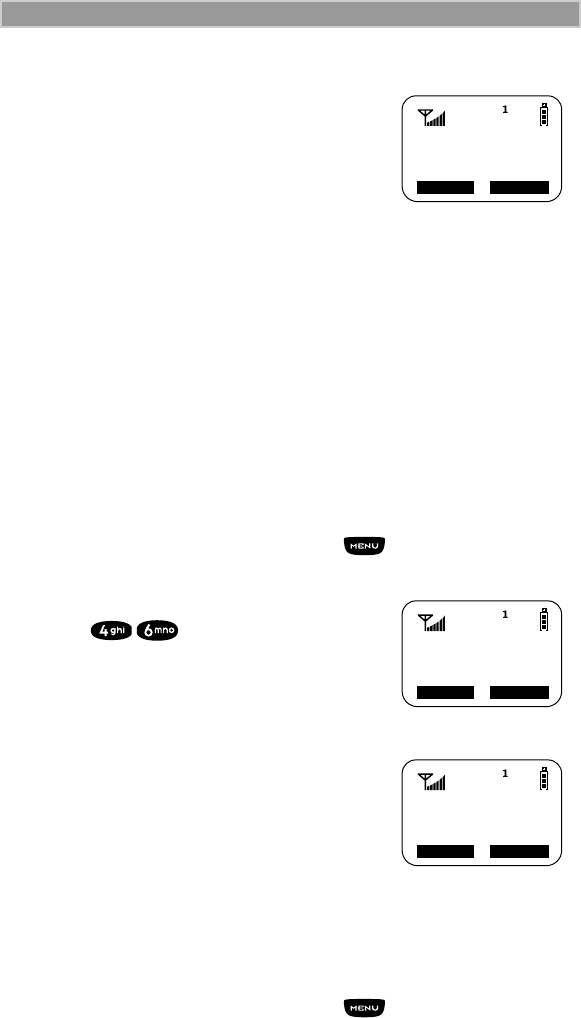
8
i2000 UserÕs Guide
3. Select “OK”.
4. At the “New PIN” screen, enter a new
PIN.
5. Select “OK.
6. At the “Repeat New PIN” screen, enter
the new PIN again.
7. Select “OK”. After the system validates
your new PIN, your phone is ready for
normal use.
Changing the PIN
To change your SIM card PIN:
1. From the Phone Ready screen, press until you see the
“Prgm” menu option.
2. Select “Prgm”.
3. Press ,
4. Select “OK”. At the “Change PIN?”
screen, select “OK”.
5. At the “Old PIN” screen, enter your
curent PIN then select “OK”.
6. At the “New PIN” screen, enter your new
PIN then select “OK”.
7. At the “Repeat New PIN” screen, enter
your new PIN again then select “OK”.
Disabling the PIN Requirement
Important!
If you disable the PIN requirement, you remove protection
of the personal data on your SIM card each time your
i
2000 is turned on.
Anyone can then use your phone and your personal data.
1. From the Phone Ready screen, press until you see the
“Prgm” menu option.
NOTE
If you unsuccessfully enter the PUK number ten times,
the PUK is blocked. If this happens, you will get a
message to call your service provider.
You may, however, make emergency calls.
New PIN
**_______
Cancl OK
46=Change
SIM PINs
Exit OK
New PIN
****
Cancl OK
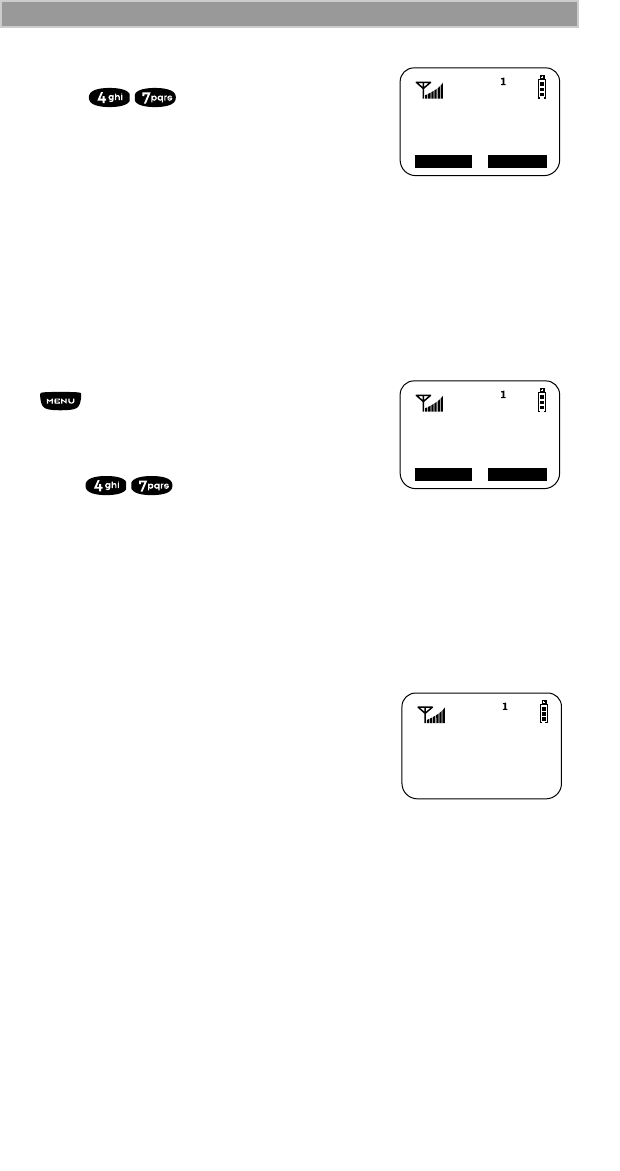
9
Getting Started
2. Select “Prgm”.
3. Press , . The “47=Require
SIM PIN:On” screen displays,
indicating that the PIN requirement is
set.
4. Select “Off”.
5. Enter your SIM PIN (your carrier provides
the initial SIM Card PIN).
6. Select “Ok”.
7. Select “Exit”.
Enabling the PIN Requirement
1. From the Phone Ready screen, press
until you see the “Prgm” menu
option.
2. Select “Prgm”.
3. Press , . The 47=Require SIM
PIN:Off” screen displays, indicating that
the PIN requirement is off.
4. Select “On”.
5. Enter your SIM PIN (your carrier provides the initial SIM Card
PIN).
6. Select “Ok”.
7. Select “Exit”.
When the PIN is enabled, you are prompted to
enter your PIN each time you turn on your
i2000 . Until a valid PIN is entered, you can
use the phone only to enter the emergency
number.
After the PIN is accepted, the Phone Ready
screen displays.
NOTE Important! Incorrectly entering your PIN three times
causes the phone to be blocked. To unblock your
phone, you must contact your carrier.
47=Require
Exit Off
SIM PIN:On
47=Require
SIM PIN:Off
Exit On
SIM Locked
Enter PIN
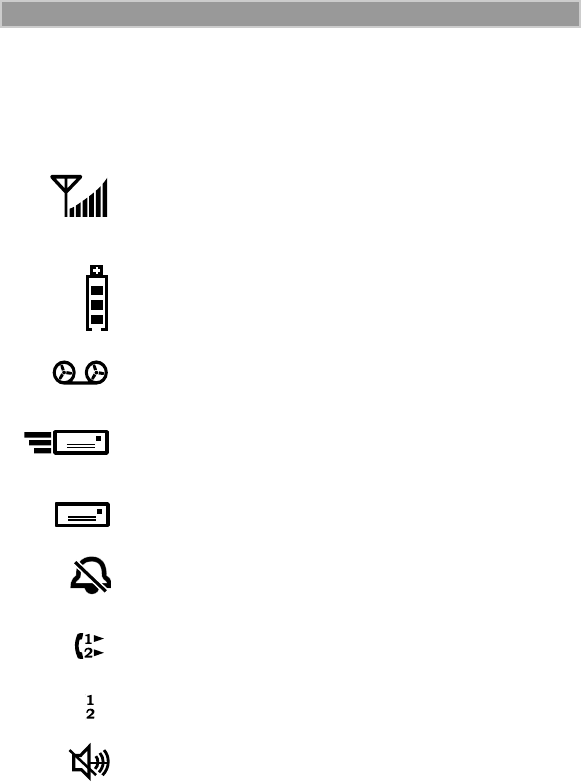
10
i2000 UserÕs Guide
Display Icons
Display icons appear on the screen to inform you of existing conditions.
See the following list.
The following icons may appear along the top of the display.
Signal Strength Indicator
Shows the signal strength. Six bars indicate the strongest
signal. Calls and messages may not be sent or received in
weak signal areas.
Battery Strength Indicator
Shows the remaining charge in your battery. Three bars
show full charge. The indicator ßashes when you have
less than Þve minutes of talk time remaining.
Voice Mail
Indicates that unplayed messages are waiting in your
voice mail box.
New Message Mail
Indicates that you have new text messages in your mail
box.
Unread Message Mail
Indicates that you have unread Message Mail.
Vibrate All
Indicates that the Vibrate All option is turned on. You
will not hear a ring tone.
Call Forward
Indicates that incoming phone calls are being forwarded.
Active Line Indication
Displays the active phone line (1 or 2).
Private/Group Speaker
Indicates that the Private/Group speaker is off. You will
hear calls through the earpiece.
11
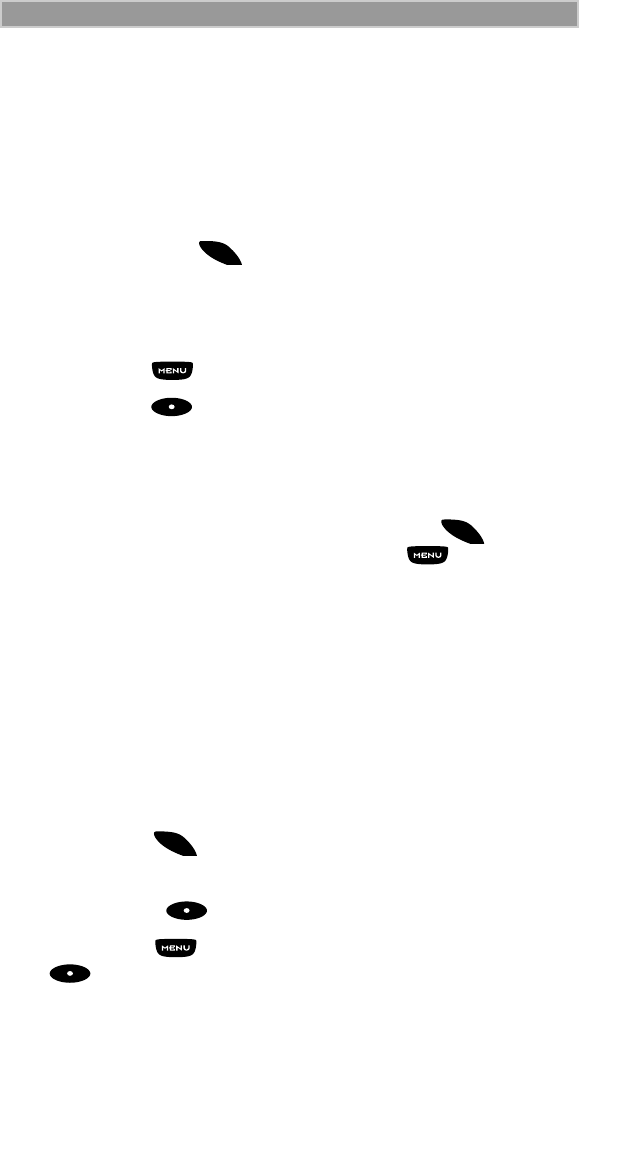
11
Getting Started
About Modes and Menus
Modes and menus are the navigational tools, providing access to the
various features of your i2000. There are four modes:
• Phone–For cellular phone calls. See page 15.
• Private–for one-to-one radio calls. See page 39.
• Group–For radio calls with all individuals in a designated talkgroup.
See page 43.
To change modes, press .
Menu choices within each mode provide access to the various features
of your i2000.
To select menu options:
(1) Press until you see the desired menu option.
(2) Press under the desired menu option.
About Modes and Menus
Modes and menus are the navigational tools, providing access to the
various features of your i2000. Pressing the Mode key takes you
through the mode choices. Pressing the Menu key takes you
through the menu options within each mode.
There are four modes:
• Phone—for cellular phone calls. See page 15.
• Private—for one-to-one radio calls. See page 39.
• Group—for radio calls with all individuals in a designated
talkgroup. See page 43.
• Net—for browser use. See the Net Mode User’s Guide.
To change modes:
Cover closed: Continue pressing “Mode” until you see the desired
mode.
Cover open: Press until you see the desired mode.
To select menu options:
Cover closed: Press under the desired menu option.
Cover open: Press until you see the desired menu option, then
press under the desired menu option to select it.
o
d
e
M
o
d
e
M
o
d
e
M
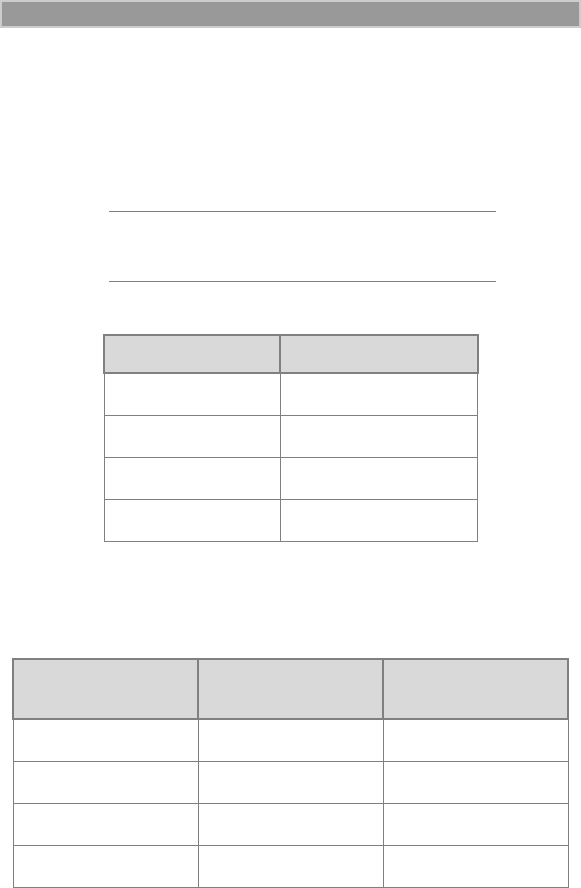
12
i2000 UserÕs Guide
Setting the Time and Date
If your carrier provides this option, you can set your phone to display
the current time and date. Unless the phone is turned off, it continues to
display the current time during a loss of service.
You have a choice of a 12- or a 24-hour clock format. See Table 2.
You have a choice of either a MM/DD (month/day) or a DD/MM (day/
month) date format. See Table 3.
If your carrier activates the time and date, they are displayed on the third
line in all modes (Phone, Private, and Group). The time of day is also
shown during an active Phone call. The time and date are not displayed
in Group mode when you select an Area option.
NOTE When this feature is activated, your phone
automatically displays local time.
Table 2: Time Display Options
12-Hour Display 24-Hour Display
12:00a 00:00
6:25a 06:25
12:00p 12:00
6:25p 18:25
Table 3: Date Display Options
Date Month/Day Format
(MM/DD) Day/Month Format
(DD/MM)
January 2nd 01/02 02/01
January 31st 01/31 31/01
October 9th 10/09 09/10
December 31st 12/31 31/12
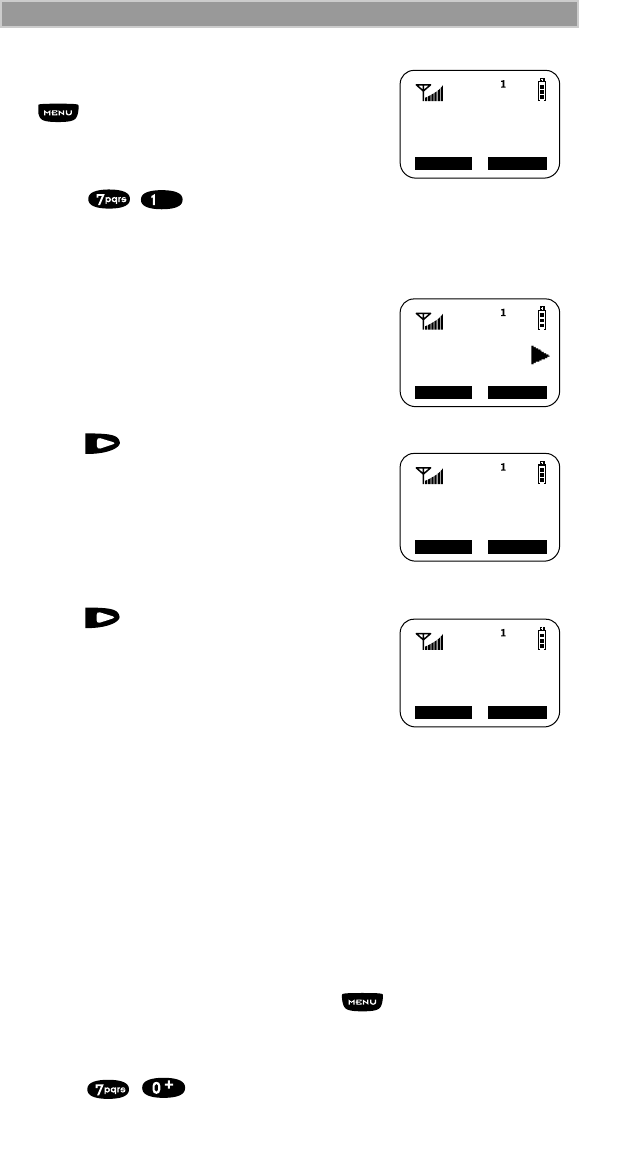
13
Getting Started
To set the time and date format:
1. From the Phone Ready screen, press
until you see the “Prgm” menu
option.
2. Select “Prgm”
3. Press , .
4. Select “Ok”. The Time/Date screen displays.
The default (preset) time and date format that
displays depends on your carrier. You can
accept the default format or select an
alternate format.
5. Press until you see the
Time Format screen.
6. Do one of the following:
• To use the 12-hour format, go to the
next step.
• To use the 24-hour format, select
“24hr”. (See Table 2 on page 12.)
7. Press until you see the
Date Format screen.
8. Do one of the following:
• To use the MM/DD format, select
“Exit”.
• Or to use the DD/MM format, select
“DD/MM”. (See Table 3 on page 12.)
9. Select “Exit”. The Ready screen for each mode (Phone, Group,
and Private) now displays the selected time and date formats.
Changing the Display Language
You can customize your i2000 to display one of four languages:
English, French, Spanish, or Portuguese. You can manually select one of
these languages or have your SIM select it for you (Automatic).
To change the displayed language:
1. From the Phone Ready screen, press until you see the
“Prgm” menu option.
2. Select “Prgm”
3. Press , .
71=Time/
Exit Ok
Date
Time/Date
Display:On
Exit Off
Time Format:
12 Hour
Exit 24hr
Exit DD/MM
MM/DD
Date Format:
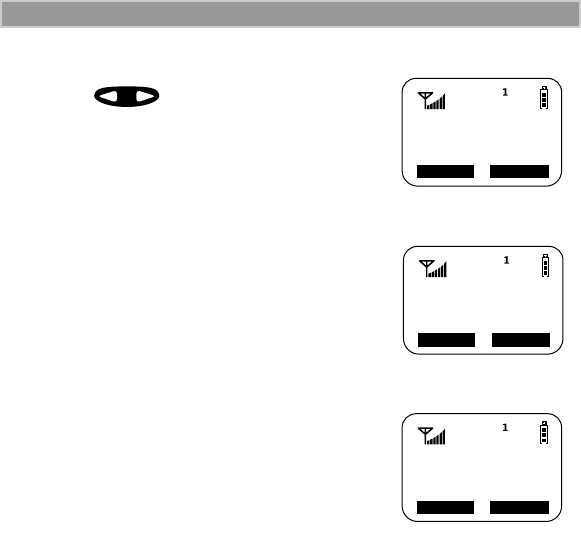
14
i2000 UserÕs Guide
4. Select “Ok”.
5. Press to scroll through the
language options.
Selecting “Exit” at any time retains the
current language selection.
6. When the desired language appears on
your display, select “Ok”. The displayed
text immediately changes to the selected
language.
7. Select “Exit”.
The language that you select will be the
displayed language.
70=Language
Automatic
Exit Ok
70=Language
English
Ok
Cancl
70=Language
Francais
OkCancl
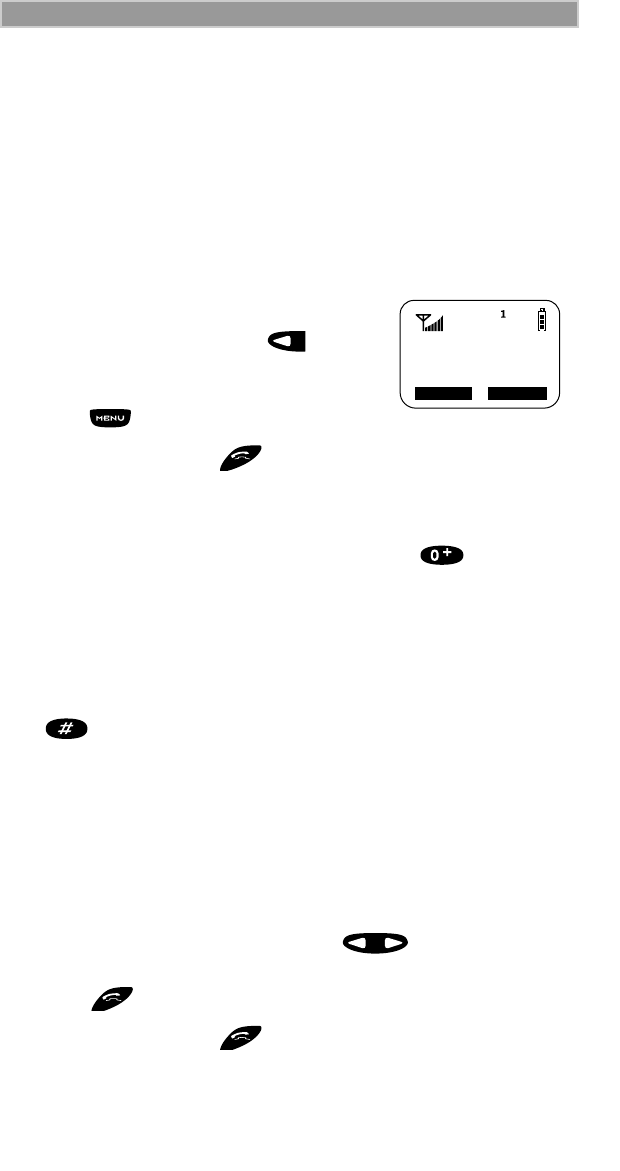
15
Making Phone Calls
MAKING PHONE CALLS
In addition to making and receiving phone calls in Phone mode, you can
use the speakerphone, set vibration alerts, forward calls, use call
waiting, put calls on hold, use three-way calling, and create and use
stored lists. Phone Ready is the main screen.
You can also have an optional, alternate line on your i2000. Your
alternate line will have its own unique number so that you can designate
special use for each line.
You can place a call by entering the phone number on the keypad.
1. From the “Phone Ready” screen, using
the keypad, enter the desired number.
If you make a mistake, press once to
move back one digit, or select “Cancl” to
start over.
2. Press to place the call.
3. To end the call, press .
International Phone Calls
To make an international phone call, press and hold . After about
two seconds, the international dialing prefix + appears in the display.
This allows you to call from any country without knowing the local
international access code.
Inserting Pauses into Phone Numbers
To add a three-second pause character to a phone number, press and
hold for about two seconds. The pause symbol (P) will appear.
Using Other Dialing Methods
To use Scroll, Speed Dial, or Name Search, names and numbers must be
programmed in your phone. See “Traveling between Systems” on
page 31.
Scroll
1. From the Phone Ready screen, press to scroll backward
or forward through your stored list of numbers and names.
2. Press to place the call.
3. To end the call, press .
Phone Ready
3:15p 08/21
Name Mail
(System Name)
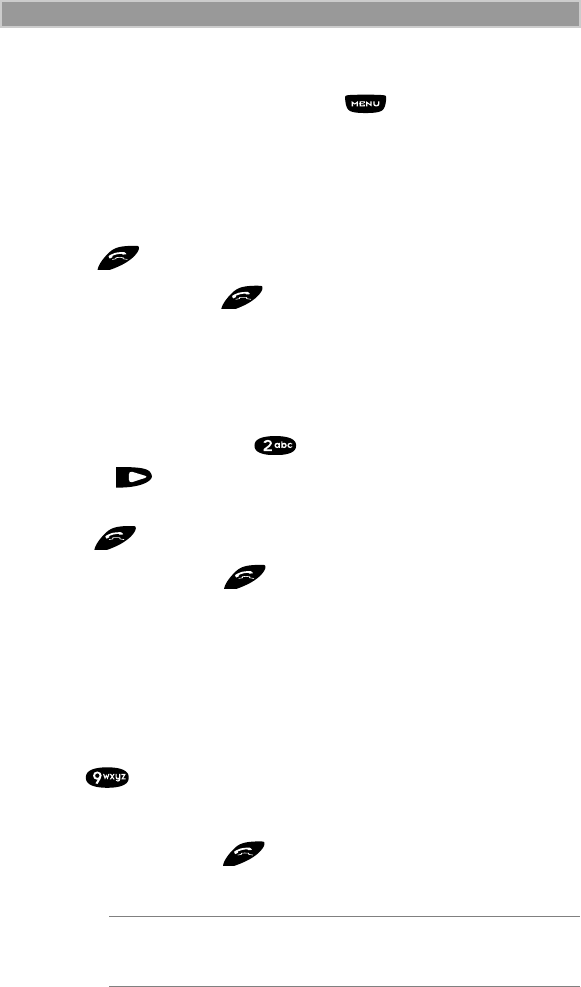
16
i2000 UserÕs Guide
Speed Dial
1. From the Phone Ready screen, press until you see the
“Spd#” option on the last line of your display.
2. Select “Spd#”.
3. Enter the assigned speed-dial number (1-100). You will see the
stored name and phone number associated with the speed-dial
number.
4. Press to place the call.
5. To end the call, press .
Name Search
1. From the Phone Ready screen, select “Name”.
2. Using the keypad, enter the first letter of the desired name, for
example, to search for the name Bob:
a. Enter “B” by pressing twice.
b. Press to scroll through all the names starting with “B” until
you see “Bob”.
3. Press to place the call.
4. To end the call, press .
Emergency Dial
You can dial the emergency phone number even if the keypad is locked.
You can make the call regardless of any security codes and, depending
on the network, with or without a SIM card inserted. If you are on an
active call, you must end it before using the emergency number.
1. From any mode (Phone, Private, or Group), press and
hold for two seconds until the phone displays
“EMERGENCY”. The phone then automatically dials the
emergency number.
2. To end the call, press . The emergency phone number will
not be saved as the last number dialed.
NOTE For more information on the Emergency Dial feature,
contact your carrier.
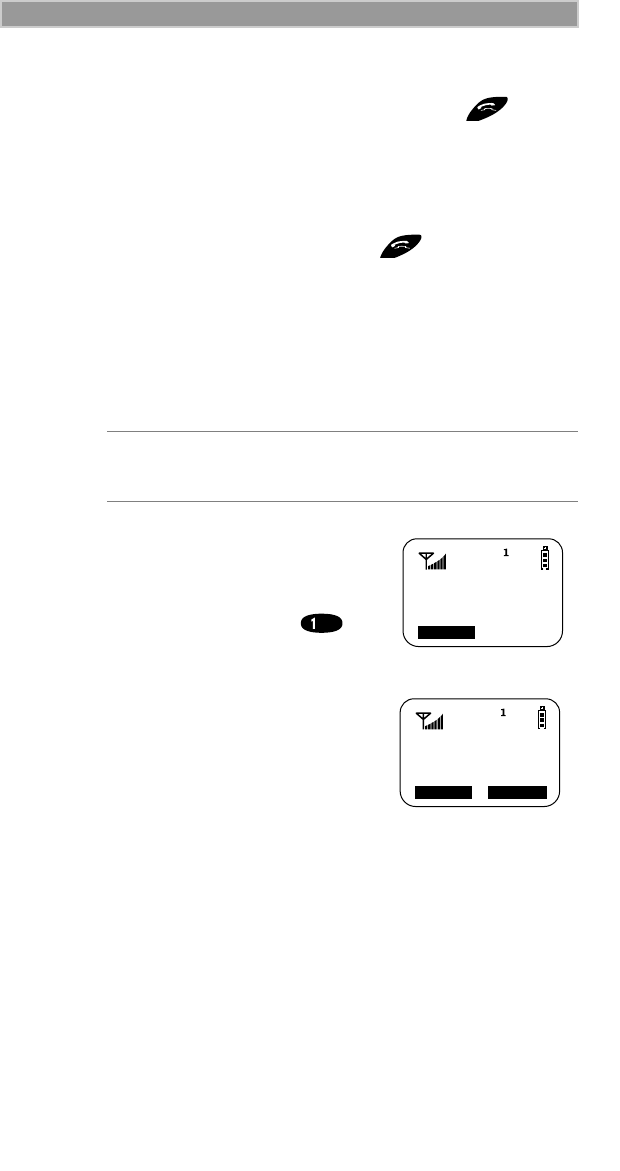
17
Making Phone Calls
Automatic Redial
If you receive a “System Busy, Try Later” message, press to have
your phone automatically redial the number. You will hear a ring-back
tone when the call is successful.
Last Number Redial
To redial the last number that you called, press .
Turbo Dial®
Turbo Dial enables you to quickly place a phone call by simply pressing
and holding the numeric key on the keypad that corresponds to the
stored entry in your Phone list directory. There are eight Turbo Dial
positions, 1 through 8.
From the Phone Ready screen, with the cover
open:
1. Select one of the first eight entries in the
Phone list using key numbers
1 through 8. For example, press for
speed dial #1. Keypad numbers 0 and 9
are not available for Turbo Dialing.
2. Press and hold the desired key for two
seconds to activate Turbo Dial. The
phone begins to dial the number and
“Phone Ready” changes to “Phone-In
Use”.
Hands-Free Speakerphone
The i2000 provides the convenience of a speakerphone for holding
impromptu meetings or listening to your voice mail messages.
During speakerphone operation, you may either speak or listen, but you
cannot do both at the same time.
Speakerphone operation varies according to whether the cover is open
or closed.
• If the cover is open during a speakerphone call and you close the
cover, you will end the call.
• If the cover is closed during a speakerphone call and you open the
cover, the call switches to the earpiece. You can switch back to
NOTE If you are on a Phone call, place the call on hold
before using Turbo Dial.
Phone Ready
1
Cancl
Phone-In Use
Voice Mail
3Way Spkr
12:45p 10/18
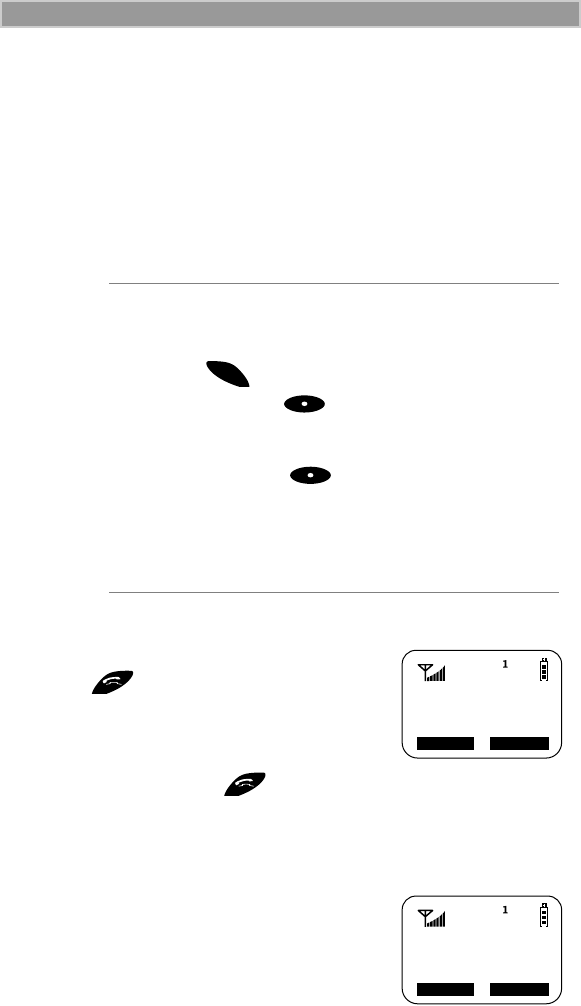
18
i2000 UserÕs Guide
speakerphone operation by selecting “Spkr”.
To use the speakerphone:
1. Select “Spkr”. The “Spkr” option flashes while the speakerphone
is on.
2. Place the phone 15-30 inches (380-760 millimeters) away from
you. In a noisy environment, you may want to move the i2000
closer to you for better transmission.
Receiving a Phone Call
1. Press or press any numeric key (0
through 9).
2. To activate the speakerphone, select
“Spkr”.
3. To end the call, press .
Missed Call Indicator
Your i2000 notifies you of received, but
unanswered phone calls. If you subscribe to
Caller ID, the caller’s phone number is stored
in your Last 10 Calls Received list. Your
screen displays a flashing message, for
example, “2 Rcvd Calls”, with the number of
missed calls.
Press any key to clear the flashing indicator.
NOTE If there is background noise in your area, you may
have difficulty hearing a caller’s voice or messages.
To resolve this problem:
1. Press until you see the “Mute” menu option.
2. To listen, press under “Mute”. The display
changes from “Phone In Use” to “Phone Mute”,
indicating that the microphone is muted.
3. To speak, press under “Mute” again. The
display changes from “Phone Mute” to “Phone In
Use”, indicating that the microphone is on.
While the microphone is muted, you can hear
incoming audio, but a caller cannot hear any speech
coming from your
i
2000.
o
d
e
M
Incoming
Phone Call Spkr
End
Phone Ready
(System Name)
Mail
Name
2 Rcvd Calls
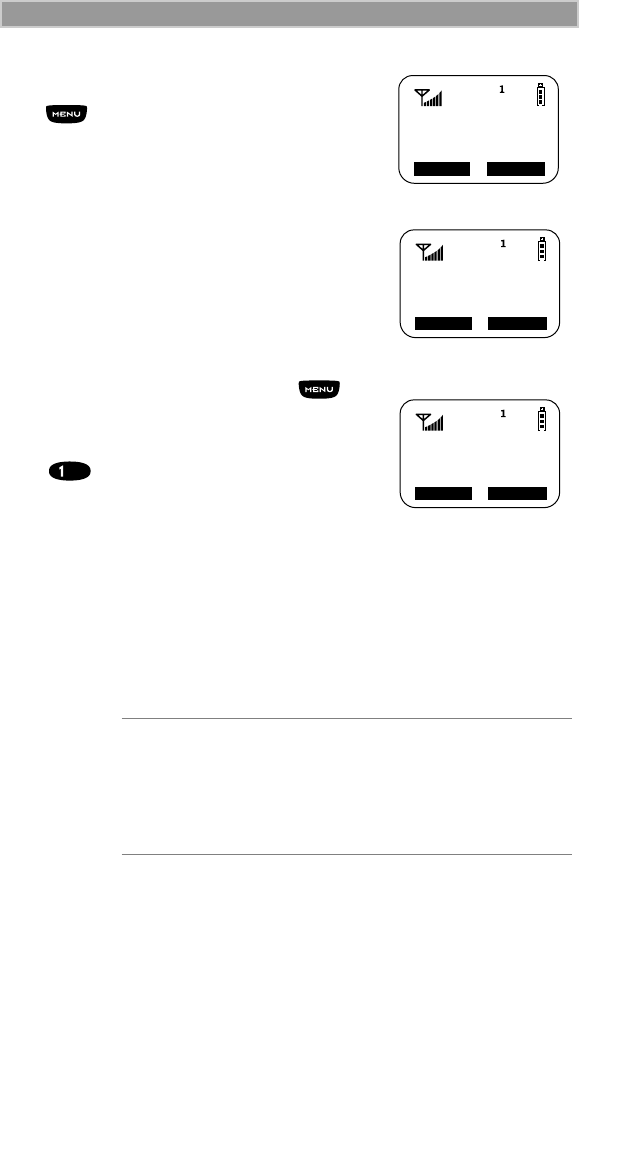
19
Making Phone Calls
To retrieve the missed calls:
1. From the Phone Ready screen, press
. The menu options change to
“Calls” and “Spd#”.
2. Select “Calls”. The Rcvd Calls screen
opens with the number, time, and date of
the last call that you received.
3. Scroll to continue viewing the list.
What Is My Phone Number?
From the Phone Ready screen, press
until you see the “Prgm” menu option.
Select “Prgm”.
Press to display your own phone
number.
VibraCall™
VibraCall is a vibration alert system that notifies you of incoming
Messages, Phone, Private, Group, and Data calls. You can set a vibration
alert for all services or for individual services.
The alert choices are:
• Vibe All—produces a vibration alert for all incoming calls and
messages.
• Phone Vibrate—produces a vibration alert for incoming phone calls.
• Phone Vibrate/Ring—produces a vibration alert followed by a ring
tone for phone calls.
• Mail Vibe—produces a vibration alert for mail messages.
• Group/Prvt Vibe—produces a vibration alert for incoming group and
NOTES When you set vibration alerts, they are set only for
the current line.
If you have a second phone line, you must select
that line and repeat the procedure for selecting all
services or selecting individual services to vibrate.
Phone Ready
(System Name)
Spd#
Calls
10:42a 11/06
Rcvd Calls
1=5552222
10:42a 11/06
Cancl Store
1=Own Ph#
9545553434
Exit Edit
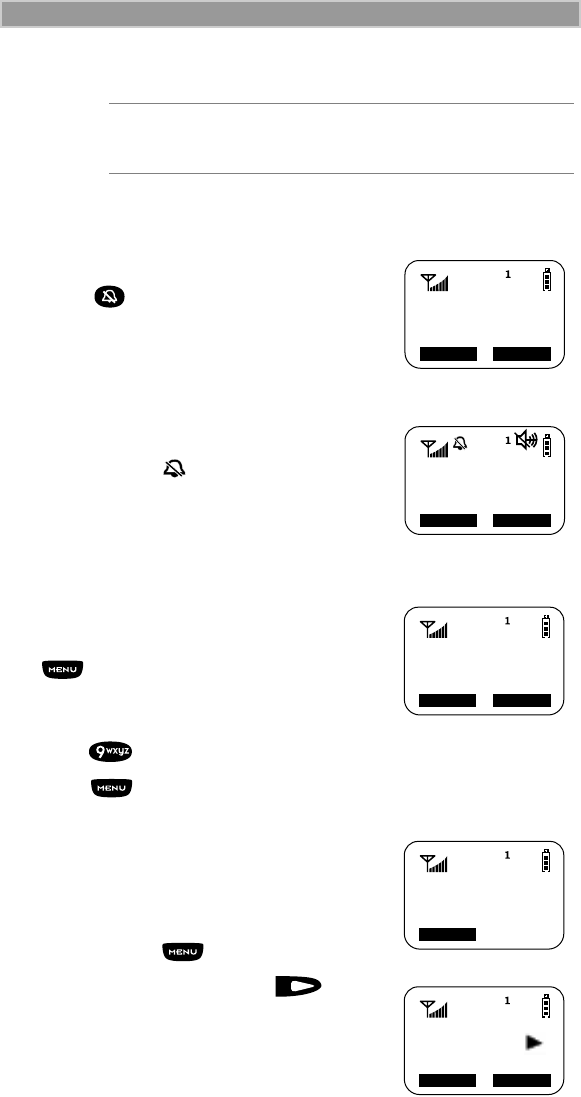
20
i2000 UserÕs Guide
private calls.
Selecting VibraCall for All Incoming Calls and Messages
To set a vibration alert for all incoming calls
and messages:
1. Press once and a “VibeAll: On”
message displays briefly.
2. Select “All”. You will receive a brief
vibration alert.
After you set the alert, the display returns to the
previous mode and (the Vibrate All icon)
appears at the top of your display.
Selecting VibraCall for Individual Services
To set a vibration alert for specific phone or
mail services:
1. From the Phone Ready screen, press
until you see the “Prgm” menu
option.
2. Select “Prgm”
1. Press .
2. Press until you see the
“Selct” menu option.
3. Select “Selct”. The first choice is Phone
Vibrate.
4. To view the Vibe/Ring vibration alert
choices, press on the keypad.
5. To view other choices, press .
• To receive vibration alerts only for
Mail, select “Mail Vibe”, then select
“On”.
• To receive vibration alerts for Group
and Private calls, select “Group/Prvt”,
NOTE If VibraCall is set for incoming calls and messages,
the power-up sequence includes a brief vibrate cycle.
Exit All
Phone Ready
(System Name)
10:54p 12/09
10:54p 12/09
(System Name)
Phone Ready
Name Mail
9=Vibrate
Alert:Off
Exit All
9=Vibrate
Alert:Off
Selct
Phone
Vibrate:
Vibrate Off
Exit Vibe
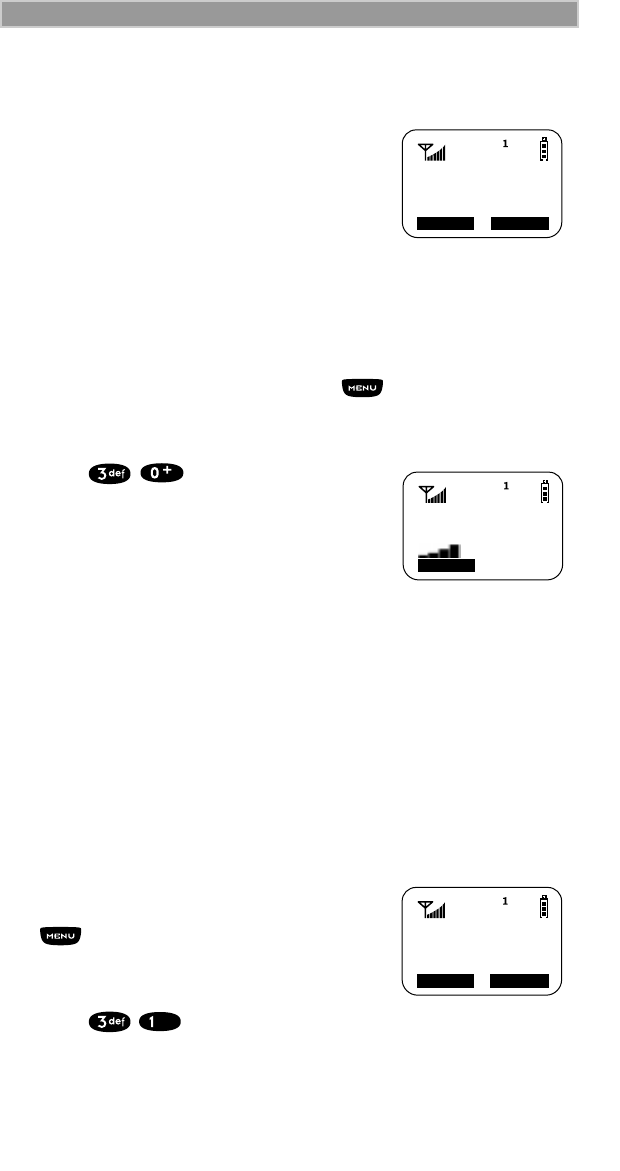
21
Making Phone Calls
then select “On”.
6. Select “Exit” to return to the Vibrate Alert
menu.
7. Select “Exit” again to return to the
previous mode.
Setting the Ringer Volume
You can adjust the ringer volume for incoming calls. If you have a
second phone line, you must set each line separately. Be sure to select
the desired line before setting the volume.
1. From the Phone Ready screen, press until you see the
“Prgm” menu option.
2. Select “Prgm”
1. Press , . The “30=Ringer
Volume” screen displays.
The display shows your current ringer
volume.
2. Press the Volume Control buttons on the
side of the phone to listen as you raise or
lower the volume. At the lowest setting,
the screen displays “Volume Silent”.
3. When you reach the desired level, select
“Exit”.
Selecting a Ring Style
Your phone has nine selectable ring styles. Phones with two phone lines
can use the same or different ring styles for each phone line.
Incoming circuit data calls have a unique, preset ring style which you
cannot change.
Setting a Ring Style
1. From the Phone Ready screen, press
until you see the “Prgm” menu
option.
2. Select “Prgm”
1. Press , .
The display shows your current ring style.
Group/Prvt
Vibe:Off
Exit On
Exit
30=Ringer
Volume
31=Set Ring
Style:1
Ok
Exit
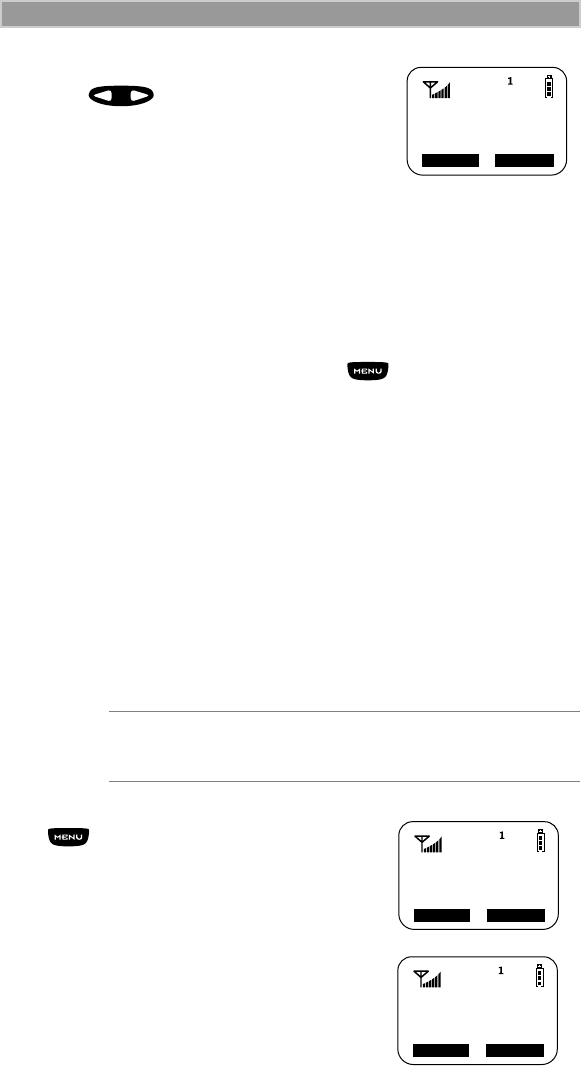
22
i2000 UserÕs Guide
2. Select “Ok”.
3. Press to scroll through the
available Ring Styles.
4. To listen to the selected ring style, press
the Volume buttons on the side of the
phone.
5. Select “Ok” to select the Ring Style
shown.
To leave the ring style unchanged, select “Cancl”
6. Select “Exit”.
Setting a Ring Style for the Alternate Line
1. From the Phone Ready screen, press until you see “Line2”.
2. Select “Line2”.
3. Repeat the procedure for "Setting a Ring Style", above.
Call Forwarding
Call forwarding lets callers reach you wherever you are. You have two
options: forward all incoming calls (unconditional) or select those
circumstances (conditional) when you want your calls forwarded.
Unconditional Call Forwarding
Unconditional call forwarding sends all incoming calls to the designated
number.
1. From the Phone Ready screen, press
until you see “Forwd” on the
last line of the display.
2. Select “Forwd”.
3. To select the number where you want
your calls forwarded, do one of the
following:
• Enter a number.
• Or, press the scroll keys to select a
number from your stored list.
4. Select “On”.
NOTE When you set unconditional call forwarding, your
phone does not ring.
Ring
Style 4
Ok
Cancl
Phone Ready
(System Name)
Forwd Memo
9:06a 09/03
Forwd:Off
To:5551212
Exit On
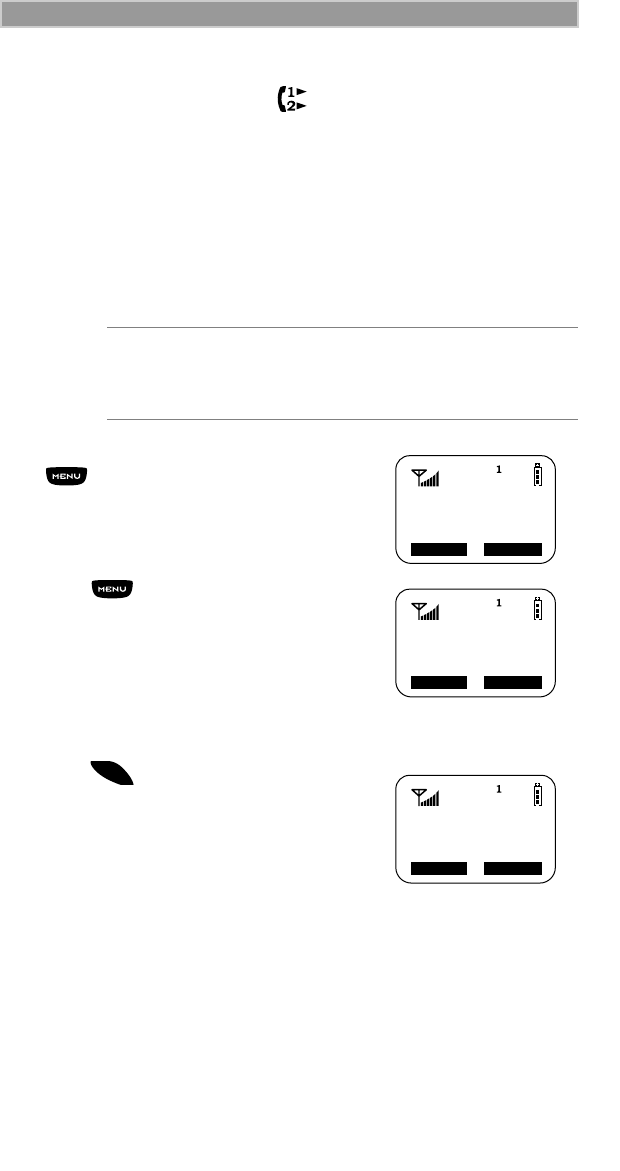
23
Making Phone Calls
5. After the “Please Wait” message displays, select “Exit”.
Notice that the Call Forward icon appears on your display when
Unconditional Call Forwarding is set.
Conditional Call Forwarding
You may want to forward your calls when your i2000 is:
• Busy on another call or the browser (Busy)
• Not answered (NoAns)
• Outside the service area (NoRch).
1. From the Phone Ready screen, press
until you see “Forwd” on the last
line of your display, then select it.
2. Press once again until you see
“Busy” and “NoAns” on the last line of
your display.
• To forward your calls when your
phone is in use, select “Busy”.
• To forward your calls when
you do not want to answer
them, select “NoAns”.
3. Press again until you see
“NoRch” and “Rcl#”.
• To forward your calls when you
cannot be reached, select “NoRch”.
• To see the call forward number,
select “Rcl#”.
4. After you select the call forward option,
either enter the number where you want your calls to be
forwarded, or press the scroll buttons and select a number.
5. Select “On”.
6. Select “Exit”.
You can set more than one condition by repeating steps 2
through 6.
NOTE You must turn off Unconditional Call Forwarding
before you can set Conditional Call Forwarding
options.
Phone Ready
(System Name)
Forwd Memo
9:06a 09/03
Forward:Off
To:
Busy NoAns
Forward:Off
To:
NoRch Rcl#
o
d
e
M
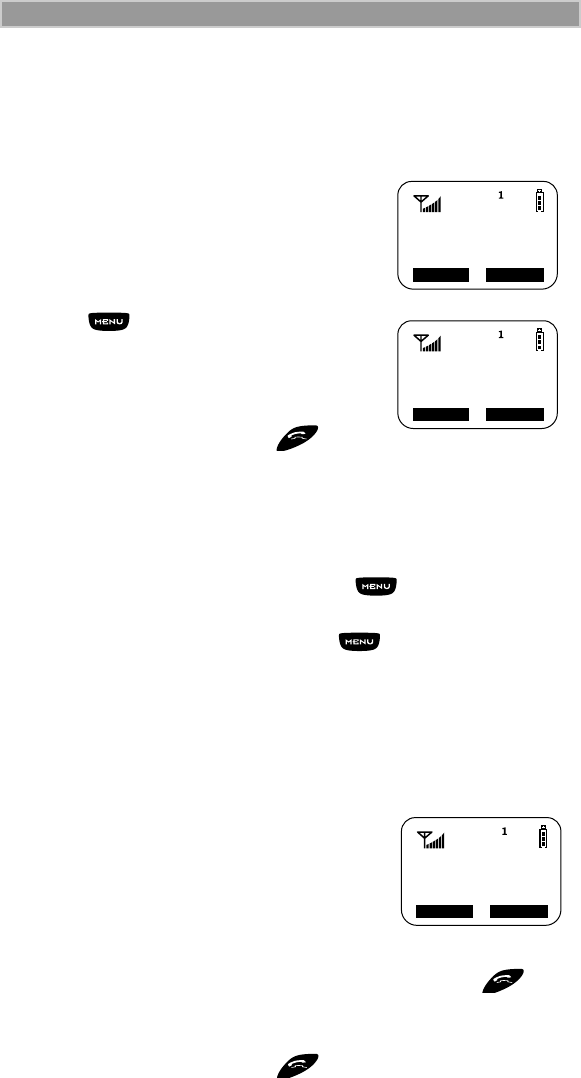
24
i2000 UserÕs Guide
Call Waiting
Using the Call Waiting feature, you can answer an incoming call when
you are on another call. Call Waiting is on unless you turn it off for a
particular call.
1. After the alert tone, your display shows
the incoming number and asks “Accept
Call?”. To accept the call, select “Yes”.
To decline the call, select “No”.
2. Press , then select “Hold” to place
the second call on hold and return to
the first call. Selecting “Hold” switches
you between the two calls.
3. To end the active call, press .
Call Hold
When you are on a call, you can place the call on hold and make a
second call.
1. To place the active call on hold, press , then select “Hold”.
You may then answer or place another call.
2. To remove the call from hold, press , then select “Hold”
again.
The options “3way” and “Spkr” appear only when you are on an active
call.
3-Way Calling
If your carrier provides 3-way calling, you can
combine two ongoing phone calls into one
conversation. This option is available only
when you initiate the second call.
After you place or receive a phone call:
1. Select “3way”. This action places the
current call on hold.
2. Enter the phone number for the second call and press .
3. When the second call is connected, select “3way” to join the
calls. Both phone numbers and “3way” appear on your screen.
4. To end the 3-way call, press .
5551212
No Yes
Accept Call?
Call 1-Hold
5551212
S
Hold Spkr
Phone-In Use
5551212
11:40p 05/08
Hold 3way
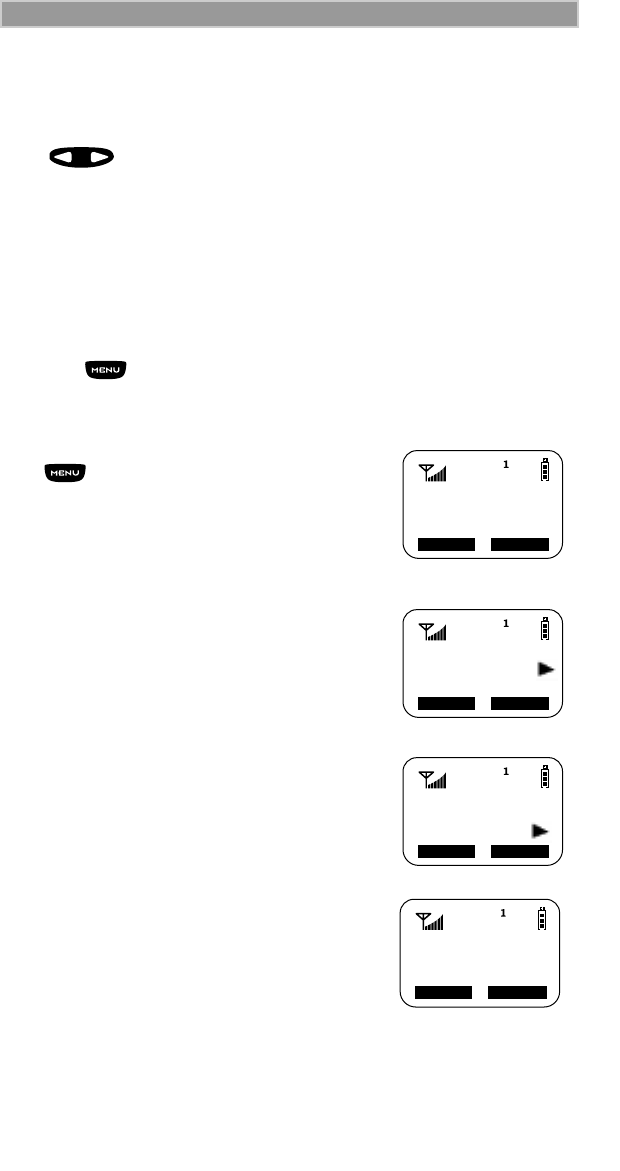
25
Making Phone Calls
Call Barring
If your carrier provides Call Barring, you can prevent incoming and
outgoing calls on your i2000.
Press to view the call barring choices (incoming, outgoing,
and recall status). See the following procedures for each.
Barring Incoming Calls
You can choose to bar:
• When Roaming—blocks all incoming calls while you roam away
from your home system.
• All Calls—blocks all incoming calls.
Press the to view the incoming call barring choices. See the
following procedure.
1. From the Phone Ready screen, press
until you see the “Bar” menu
option.
The time, date, and menu option,
“Line2”, do not appear in GSM.
2. Select “Bar”. The “Call Barring
Incoming” screen displays.
3. Select “Ok”. The “Bar Incoming:Off”
screen displays.
4. Do one of the following:
• To leave the incoming call barring as
shown (in this example, off), select
“Exit”.
• Or, to bar all incoming calls, select
“All”. At this point, you are required
to enter your passcode.
5. Enter your call barring passcode and
select “OK”.
Barring Outgoing Calls
You can choose to bar:
Phone Ready
Bar Line2
(SystemName)
2:12p 09/03
Call Barring
Exit OK
Incoming
Bar
Exit All
Incoming:
Off
Enter Bar
Cancl OK
Passcode
****
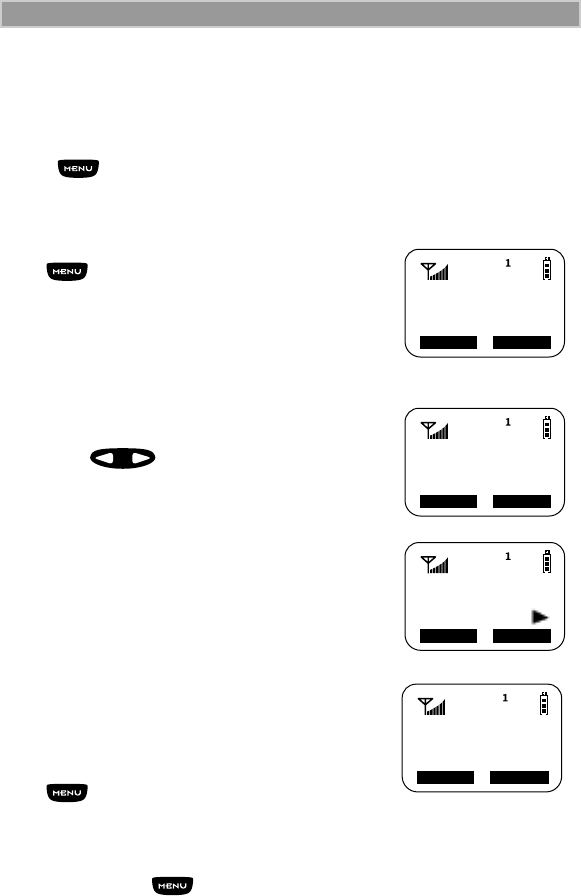
26
i2000 UserÕs Guide
• International Calls—blocks all outgoing international calls.
• International Calls except Home Country—blocks all outgoing
international calls except to your home country.
• All Calls—blocks all outgoing calls.
Press to view the outgoing call barring choices. See the
following procedure.
1. From the Phone Ready screen, press
until you see the “Bar” menu
option.
The time, date, and menu option,
“Line2”, do not appear in GSM.
2. Select “Bar”. The “Call Barring
Incoming” screen displays.
3. Press once. The “Call Barring
Outgoing” screen displays.
4. Select “Ok”. The “Bar Outgoing:Off”
screen displays.
5. Do one of the following:
• To leave the outgoing call barring as
shown (in this example, off), select
“Exit”.
• Or, to bar all incoming calls, select
“All”. At this point, you are required
to enter your call baring passcode
and select “OK”.
6. To access the “Intl” menu option, press
.
7. Do one of the following:
• Select “All” to bar all outgoing international calls.
• Or, press again to select “xHome” to bar all outgoing
calls except to your home country.
Viewing Call Barring Status
To view the Call Barring status:
Phone Ready
Bar Line2
(SystemName)
2:12p 09/03
Call Barring
Exit OK
Outgoing
Bar
Exit All
Outgoing:
Off
Enter Bar
Passcode
Cancl OK
*****
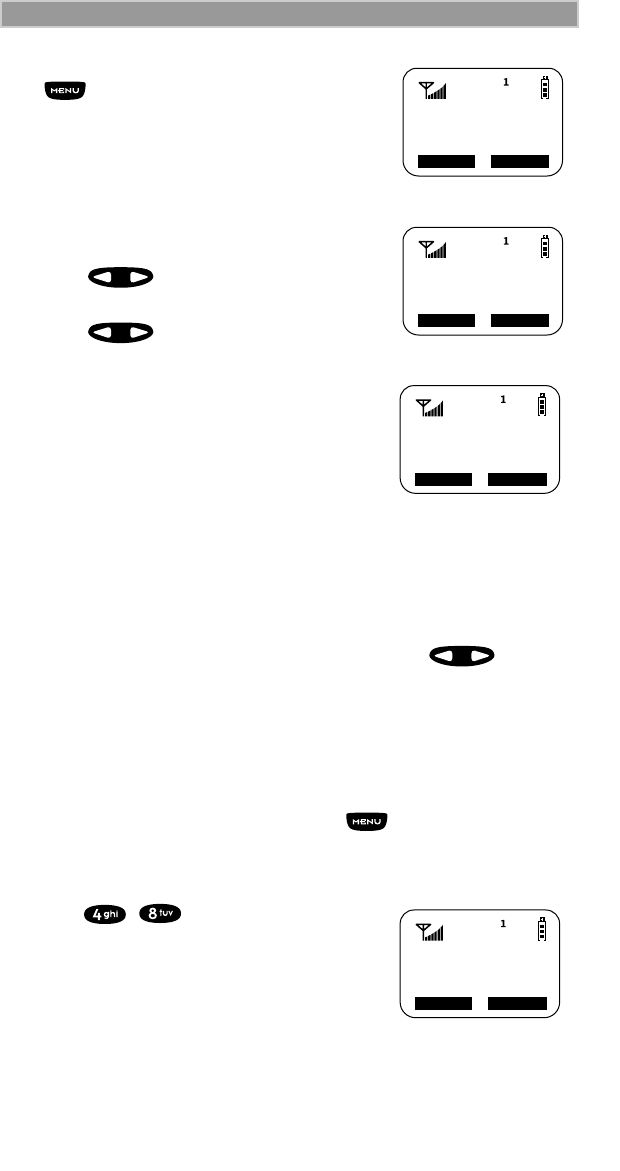
27
Making Phone Calls
1. From the Phone Ready screen, press
until you see the “Bar” menu
option.
The time, date, and menu option,
“Line2”, do not appear in GSM.
2. Select “Bar”. The “Call Barring
Incoming” screen displays.
3. Press . The “Call Barring
Outgoing” screen displays.
4. Press again. The “Call Barring
Recall Status” screen displays.
5. Select “OK”. At this point, you are
required to enter your passcode then
select “OK”. Next, the “Please Wait”
message displays.
If you enter the wrong passcode, the
“Wrong Bar Passcode” message displays
then the “Enter Bar Passcode” screen
displays again. Carefully re-enter your
passcode. It must be between 4 and 8 digits.
6. After the “Please Wait” message, the “Call Bar Incoming:Off”
screen displays. Do one of the following:
• To view only the Call Bar Incoming status, select “OK”.
• To view the Call Bar Outgoing status, press , then
select “OK”.
Changing Your Call Barring Passcode
To change your call barring passcode:
1. From the Phone Ready screen, press until you see the
“Prgm” menu option.
The time, date, and menu option, ÒLine2Ó, do not appear in GSM.
2. Press , . The “48=Change Bar
Passcode” screen displays.
3. Select “OK”. The “Old Code?” screen
displays.
4. Enter your current passcode then select
“OK”. Thew “New Code?” screen
displays.
5. Enter your new passcode then select “OK”.
Phone Ready
Bar Line2
(SystemName)
2:12p 09/03
Call Barring
Exit OK
Recall
Status
Enter Bar
Passcode
Cancl OK
*****
48=Change
Bar Passcode
Exit OK
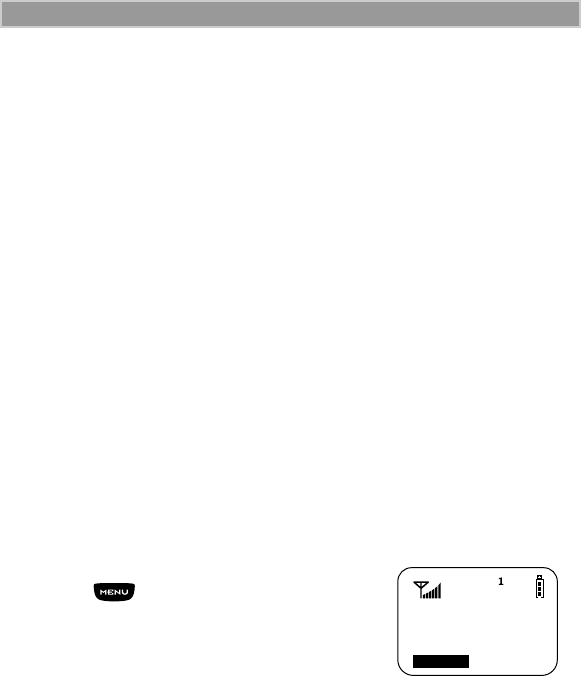
28
i2000 UserÕs Guide
6. At the “Repeat Code” screen, enter your new passcode again then
select “OK”.
Be sure to record your new passcode and store it in a safe place.
Alternate Phone Line (iDEN Only)
If your phone is activated with two phone lines, you can switch between
them. To change phone lines, your phone must be at the Phone Ready
screen. The following settings are independent for each phone line.
When you enable a setting, it applies only to the active line.
• Ringer Volume
• Auto Answer
• One-minute Beep
• Automatic Display Timer
• Resettable Timer
• Total Call Timer
• Selectable Ring Styles
• Call Forwarding
Setting the Active Line
At the “Phone Ready” screen:
1. Press until you see “Line2”. (If
you are on Line 2, you will see “Line1”.)
2. Do one of the following:
• Select “Line2” to activate Line 2
when Line 1 is the active line.
• Or, select “Line1” to activate Line 1 when Line 2 is the
active line.
Outgoing calls will be made on the selected line.
Receiving a Call
You can receive calls on either line, regardless of the active line setting.
• If you receive a call on the currently active line, that icon simply
flashes.
• If you receive a call on the line that is not currently active, the active
line icon remains lit and the alternate line icon flashes.
Phone Ready
(System Name)
Line2
11:48p 08/21
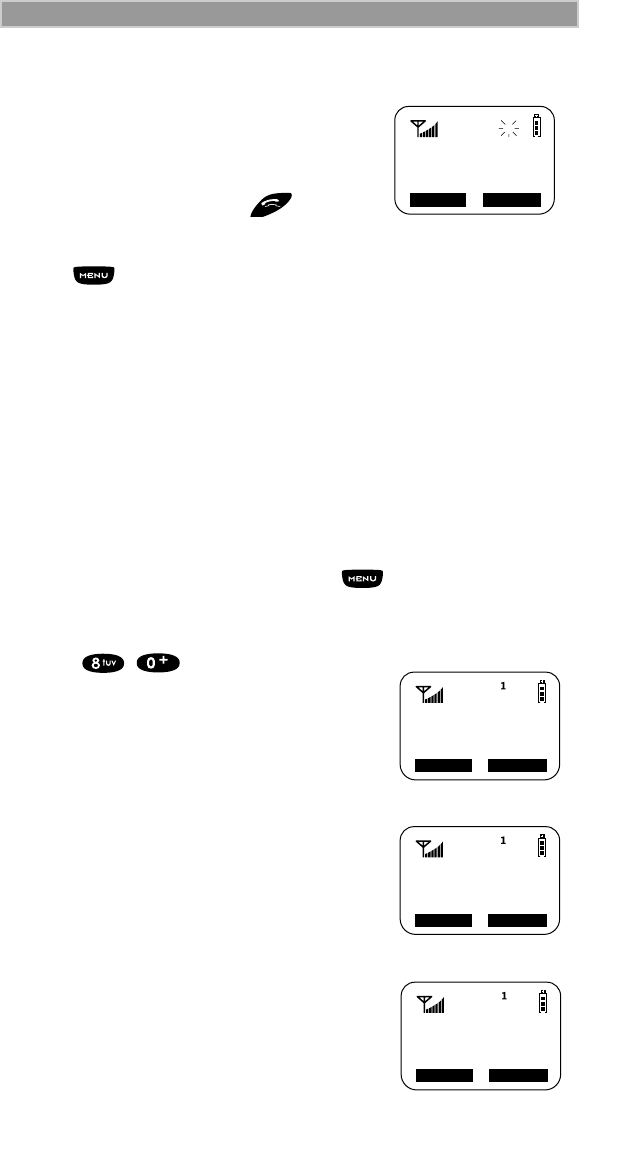
29
Making Phone Calls
Receiving a Call on Your Alternate Line
1. Select “Yes” to answer the call on the
other line. Your previous call will be
placed on hold.
2. Do one of the following:
• To end the call, press .
• Or, to place the current call on hold,
or to toggle between calls, press
, then select “Hold”.
When the call ends, the phone remains active in the last active line
selected.
Phone Only Mode (iDEN Only)
If your carrier provides this option, you can turn off Private and Group
services. You can still make and receive phone calls and receive
Message Mail.
Placing the phone in Phone Only mode increases the standby battery
life. Make sure that the LED is blinking green, which indicates that you
are in a coverage area.
To turn on Phone Only mode:
1. From the Phone Ready screen, press until you see the
“Prgm” menu option.
2. Select “Prgm”
1. Press , .
2. Select “On”.
3. Select “Exit”.
The “Phone ONLY” message displays. Group
call and Private call services are now
suspended.
3055551212
Accept Call
On Line 2?
No Yes
1
2
80=Phone
Only:Off
On
Exit
80=Phone
Only:On
Exit Off
Phone ONLY
2:12p 07/21
Name Mail
(System Name)
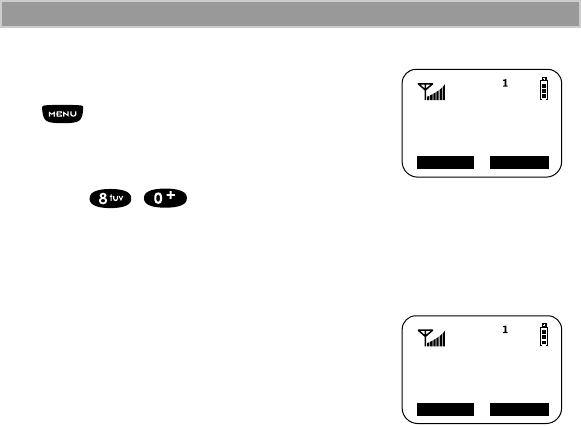
30
i2000 UserÕs Guide
To restore all services:
1. From the Phone Ready screen, press
until you see the “Prgm” menu
option.
2. Select “Prgm”
1. Press , .
2. Select “Off”.
3. Select “Exit”. The display returns to
Phone Ready.
All services are now available.
80=Phone
Only:On
Exit Off
80=Phone
Only:Off
Exit On
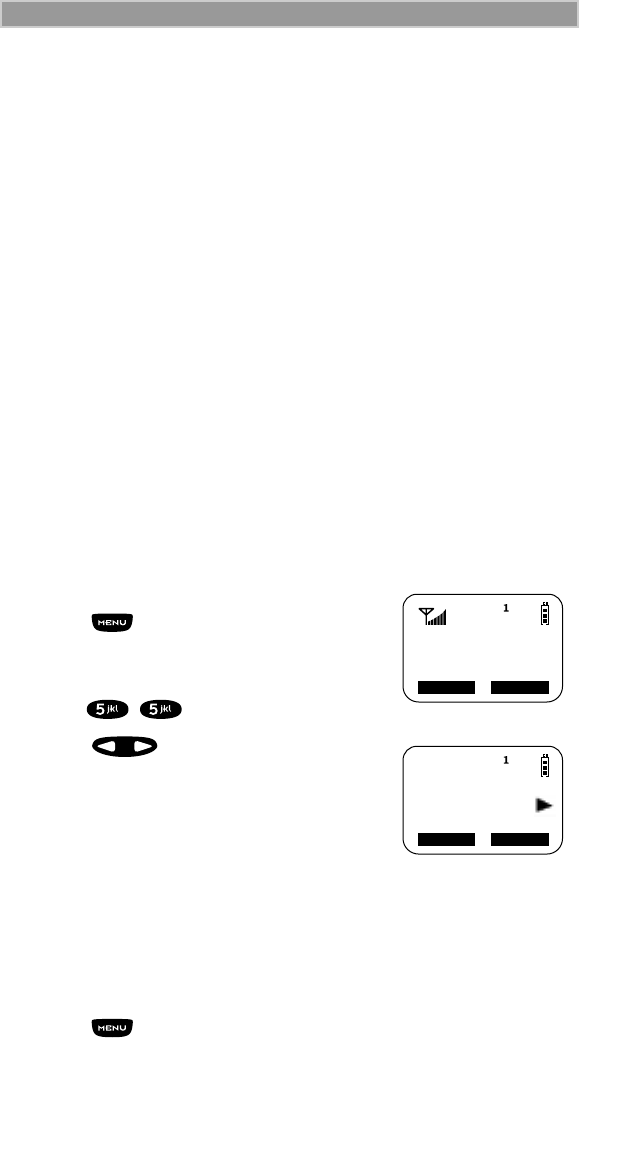
31
Traveling between Systems
TRAVELING BETWEEN SYSTEMS
When you travel, you may have to change the phone system setting. You
can choose from six phone system settings:
• Last active—useful when you move between iDEN and GSM
systems that do not overlap, for example, traveling between New
York and Paris. If your
i
2000 cannot locate the last system, for
example, iDEN, it attempts to locate the other system, GSM.
• Roam all—useful when you are in an overlapping system-coverage
area and have no preference for either system. This selection causes
your
i
2000 to switch between iDEN and GSM until it finds an
acceptable network.
• iDEN preferred—useful if your home system is iDEN and you are in
a country or region where GSM coverage is also available. Your
i
2000 always searches first for iDEN networks.
• iDEN only—useful when you are in an area that is covered by iDEN
and GSM, but you want to use iDEN. Your
i
2000 attempts to register
only on iDEN networks.
• GSM preferred—useful if your home system is GSM and you are in
a country or region where iDEN coverage is also available. Your
i
2000 always searches first for GSM networks.
• GSM only—useful when you are in an area that is covered by iDEN
and GSM, but you want to use GSM. Your
i
2000 attempts to register
only on GSM networks.
To reselect the phone system:
1. Press until you see the “Prgm”
menu option.
2. Select “Prgm”.
3. Press , , then select “OK”.
4. Press until you see the desired
system.
Searching for a Network
While you are on a GSM network, you can perform an automatic or
manual search for available networks. A manual search allows you to
view the available networks and make a selection rather than use the
network automatically provided by your carrier.
1. Press until you see the “Prgm” menu selection.
2. Select “Prgm”.
55=Phone Sys
Exit OK
Phone System
Phone System
Cancl OK
Last Active
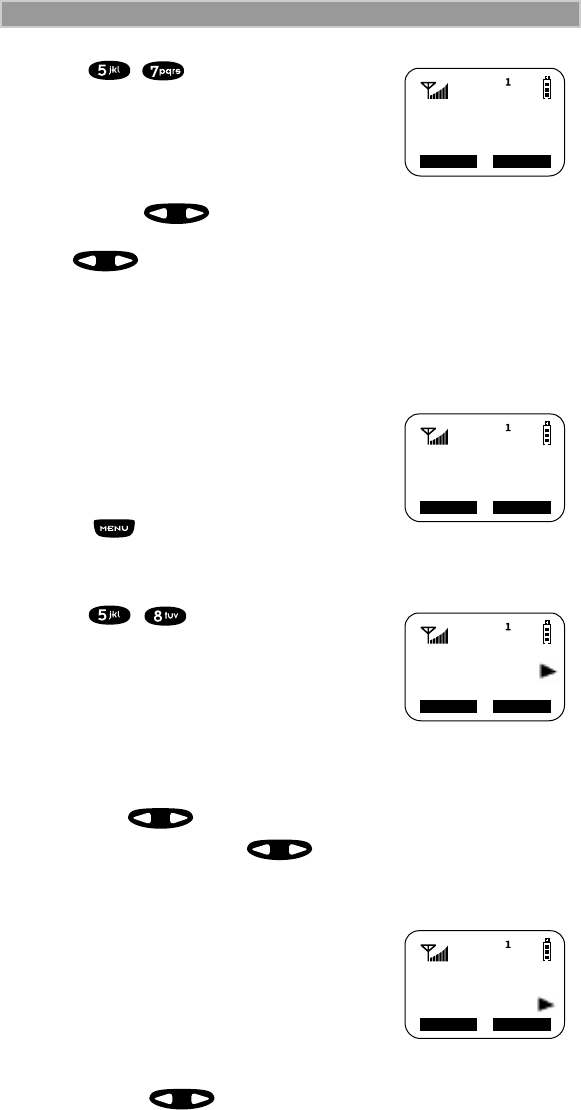
32
i2000 UserÕs Guide
3. Press
,.
4. Select “OK”
5. At the “57=GSM Network Search”
screen, do one of the following:
¥ Select ÒOKÓ.
¥ Or, press . At ÒManual
SearchÓ, select ÒOKÓ. Then press
to
scroll through the
network choices.
The network choices
appear in the following order: Home,
Preferred, Available.
Storing Your Preferred List of Networks
While you are on a GSM network, you can
add, edit, or erase your preferred list of
networks. This is useful if your carrier
adds new roaming partners.
1. Press until you see the “Prgm”
menu selection.
2. Select “Prgm”.
3. Press
,.
4. Select “OK”. The “Add New Entry?”
screen displays.
5. At the “Add New Entry?” screen, select
“OK”. This selection opens a network
screen.
6. Do one of the following:
• To add this network, select “Ok”.
• Or, to exit this screen without adding
this network, select “Cancl”.
• Or, press to view or enter another available or known
NOTE
From the “Add New Entry?” screen, you may press
to go to the “Edit Entry” or “Erase Entry?”
screen. Press to view the network choices
for each screen.
57=GSM
Exit OK
Network
Search
58=GSM
Exit OK
Network List
Add New
Cancl OK
Entry?
UK Cellnet
Cancl OK
234 10 UK
Available
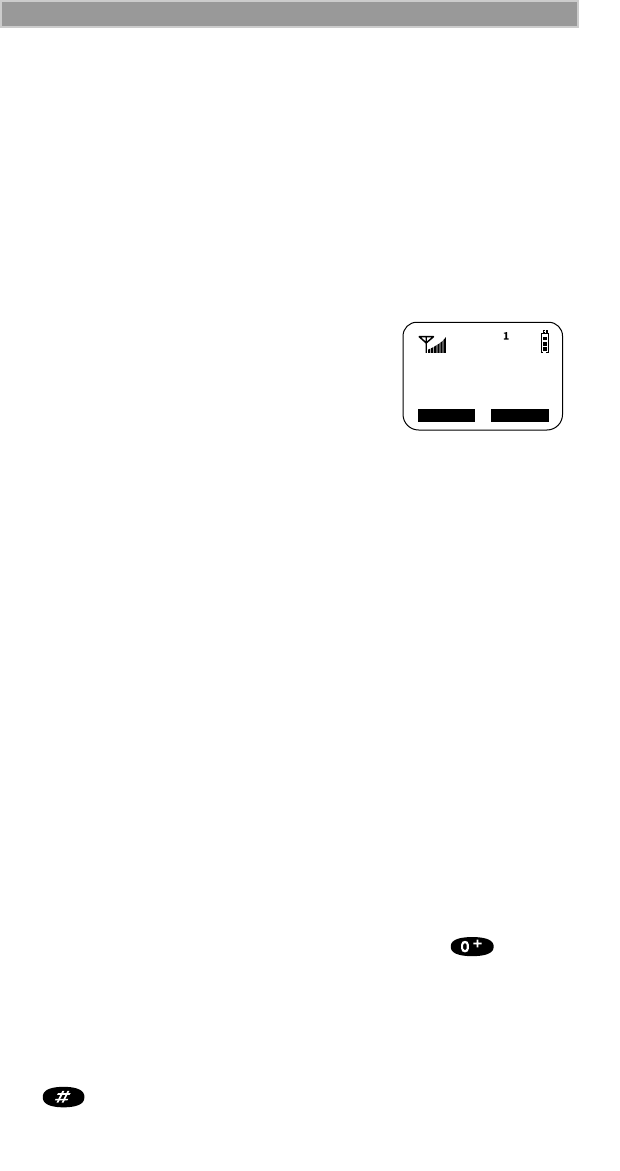
33
Traveling between Systems
network. At the desired network screen, select “OK”.
Selecting “OK” adds the displayed network to your preferred network
list.
7. At the preferred network screen, for
example, UK Cellnet Pref#=_, assign a
number, 1 through 8, to the network
name.
The number that you assign provides the
priority in which the phone looks for the
systems when it is scanning the preferred
list of networks.
8. Select "OK”.
Creating, Editing, and Using Stored Lists
A stored list is a directory of phone numbers and Private IDs and their
related names. Stored lists are convenient because you do not have to
remember names and numbers—you simply scroll through your stored
list.
Combined Phone Number and Private ID List
You can set a combined Phone and a Private ID with the associated
name, which eliminates the need to program the Private ID separately.
You can add up to 100 numbers to your Phone list, store them with
names, and assign them to speed-dial numbers.
Entering Numbers
To enter a number, press the corresponding key on the keypad.
Entering International Phone Numbers
To enter an international phone number, press and hold . After
about two seconds, the international dealing prefix + will appear in the
display. This allows you to call from any country without knowing the
local international access code.
Inserting Pauses into Phone Numbers
To obtain a three-second pause character in a phone number, press and
hold for about two seconds. The pause symbol (P) will appear.
NOTE
You can assign numbers 1 through 8 to your preferred
network names. However, if you assign a new network
name to a number that already has a stored network
name, you will erase the stored name.
UK Cellnet
Cancl OK
Pref#=_
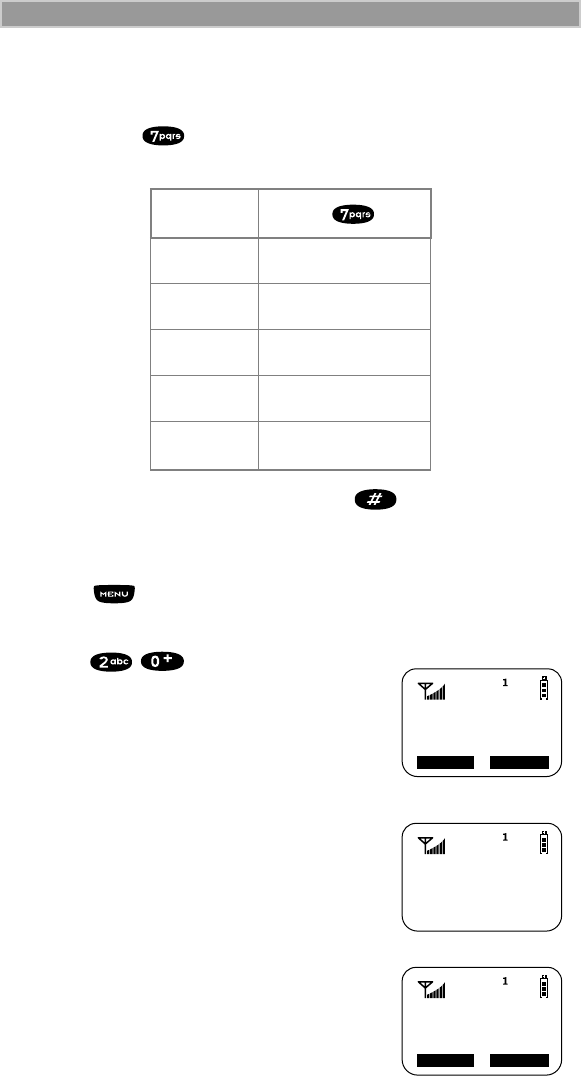
34
i2000 UserÕs Guide
Entering Names
To enter a letter, press the key the required number of times, which is
related to the letter’s position on the key. Table 4 describes how to enter
each letter on the key.
Table 4: Entering Letters and Numbers on the Keypad
To shift to lowercase letters, press and hold after a letter is
entered.
Storing Names and Numbers
1. Press until you see the “Prgm” menu selection.
1. Select “Prgm”.
2. Press , .
3. Select “Ok”.
The next screen briefly displays the remaining
number of phone numbers and private IDs that
you can store.
4. Enter the name that you wish to store.
5. Select “Store”.
See Figure 2. for an example of entering
a name.
To enter: Press
P
once
.
Q
twice
.
R
three times
.
S
four
times
.
7
five times
.
20=Phone/
Prvt List
Exit Ok
Available
98 Phone #
3 Prvt IDs
Enter Name
Exit Store
_
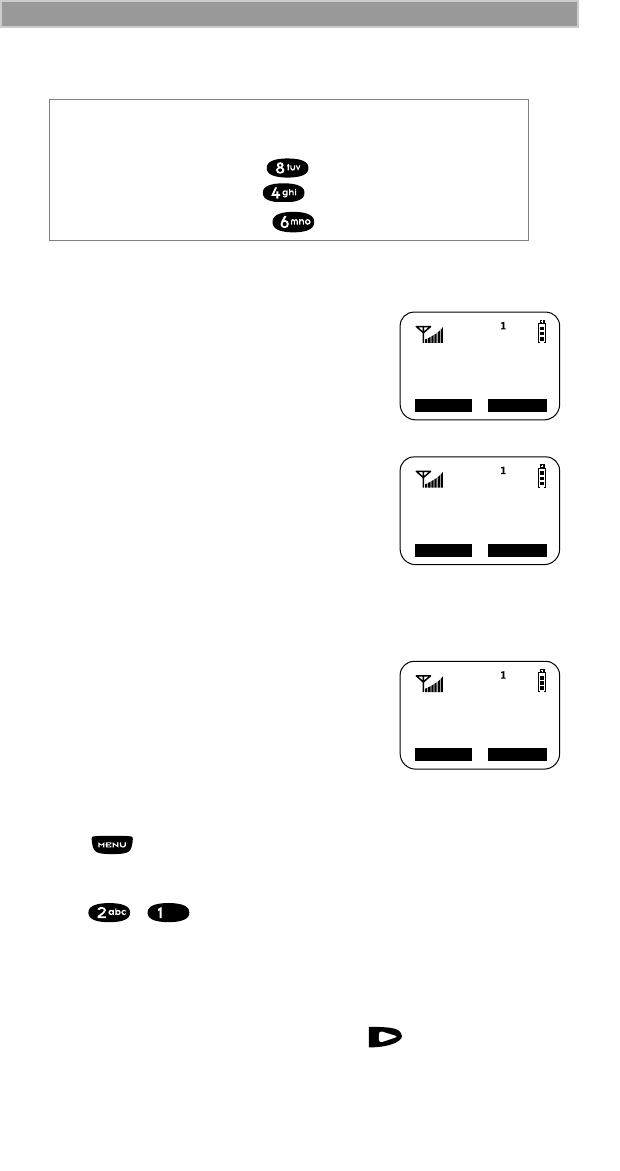
35
Traveling between Systems
Figure 2. Entering a Name
5. Enter the phone number that you want to
associate with this name and select
“Store”.
To skip the Phone Number entry, select
“Skip”. You will go directly to the
“Enter Prvt ID Number” screen.
The next screen displays the name that you
entered and a flashing speed-dial number
where the entry will be stored.
6. Do one of the following:
• To accept the speed-dial number
shown, select “Store”.
• To change the speed-dial number,
enter the desired speed-dial number. The speed-dial number
stops flashing.
7. At the next screen, enter the Private ID
number associated with the name that
you entered then select “Store”.
To skip the Private ID number entry, select
“Skip”.
Editing and Erasing Phone List Entries
1. Press until you see the “Prgm” menu selection.
2. Select “Prgm”.
3. Press , .
4. Select “Ok”. The “Edit Entry?” screen displays.
5. Do one of the following:
a. To edit an entry, select “Ok”.
(1) At the “Edit Entry” screen, press until the desired
entry appears, then select “OK.
(2) At the “Edit Number” screen, edit the phone number, if you
EXAMPLE
To store the name “TIM”:
1. Enter “T” by pressing once.
2. Enter “I” by pressing three times.
3. Enter “M” by pressing once.
Skip Store
Enter Phone
Number
_
TIM
Spd#=3
Cancl Store
Enter Prvt
ID Number
Skip Store
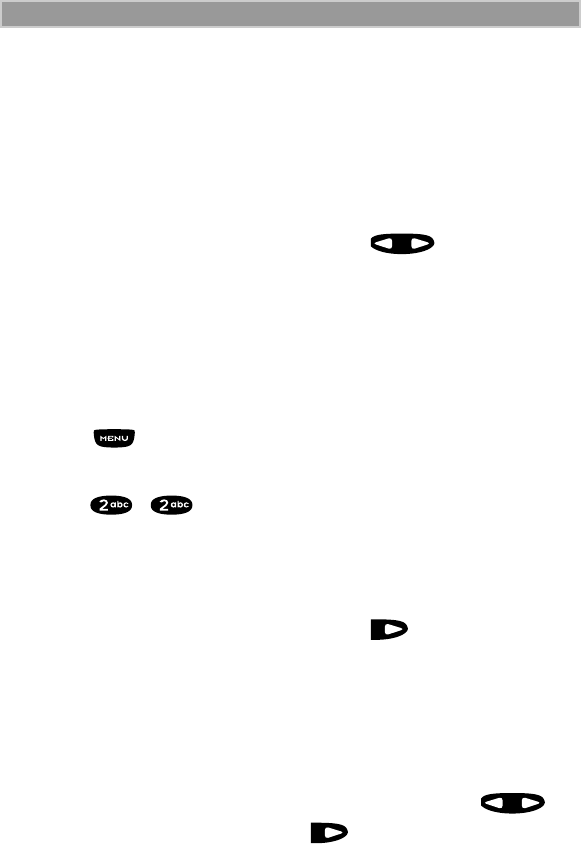
36
i2000 UserÕs Guide
wish, then select “Store”.
(3) At the “Edit Name” screen, edit the name, if you wish, then
select “Store.
(4) At the “Edit Spd#” screen, edit the speed number, if you
wish, then select “Store”.
b. To erase an entry:
(1) At the “Edit Entry” screen, press .
(2) At the “Erase Entry” screen, select “Ok”.
(3) Scroll to the desired entry, then select “Ok”. At the “Erase
Entry?” screen, select “Yes”.
4. Select “Exit” to close the Phone List Edit screen.
Editing and Erasing Private ID List Entries
1. Press until you see the “Prgm” menu selection.
2. Select “Prgm”.
3. Press , .
4. Select “Ok”. The “Edit Entry?” screen displays.
5. Do one of the following:
a. To edit an entry, select “Ok”.
(1) At the “Edit Entry” screen, press until the desired
entry appears, then select “OK.
(2) At the “Edit ID” screen, edit the number, if you wish, then
select “Store”.
(3) At the “Edit Name” screen, edit the name, if you wish, then
select “Store.
b. To erase an entry at the “Edit Entry” screen, press
once, then select “Ok”. Press to scroll to the desired
entry, then select “Ok”. At the “Erase Entry?” screen, select
“Yes”.
4. Select “Exit” to close the Private ID List Edit screen.
Last 10 Calls Received and Sent Lists
If you subscribe to your carrier’s Caller ID service, you can view, dial,
and store the list of the last ten phone numbers received and the last ten
phone numbers dialed.
The most recent call sent or received appears first in your call list.
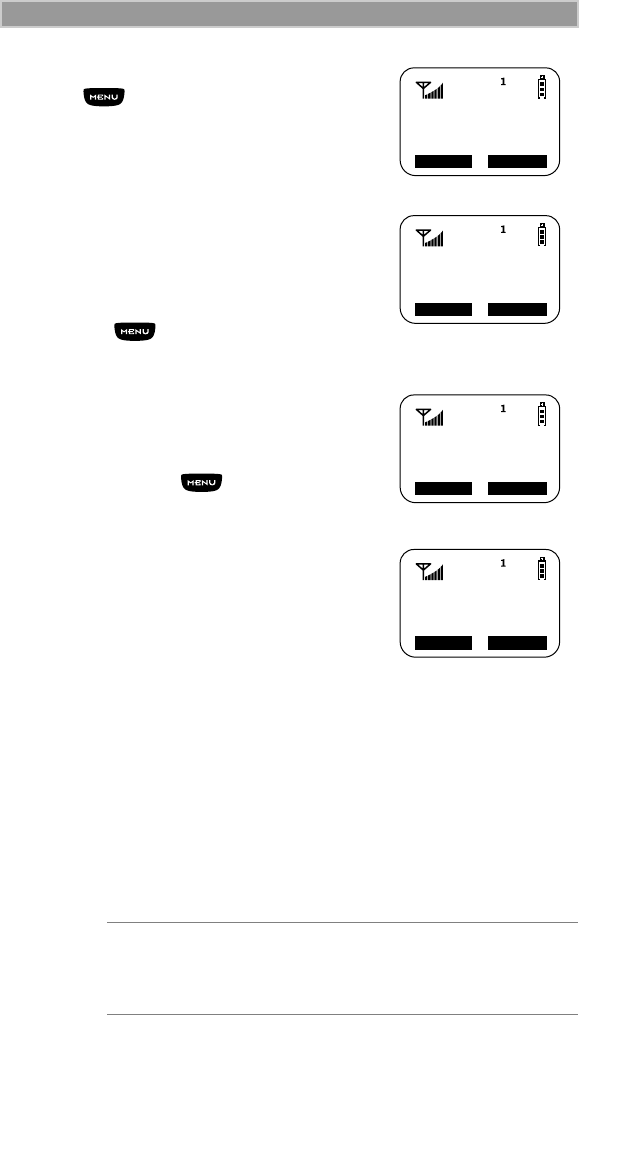
37
Traveling between Systems
From the Phone Ready screen:
1. Press . The menu options change to
“Calls” and “Spd#”.
2. Select “Calls”. The Rcvd Calls screen
opens.
If the “Store” option appears, the
number currently displayed is not in
your Phone list.
To add the number
to your list, select “Store”.
If you want to see the Sent list but the
“Store” option is on your display,
press
until you see the “Sent”
menu option
.
3. Do one of the following:
• To view the Calls Received list, use
the Scroll key to view each entry.
If the “Store” option is on your
display, press until you see the
“Rcvd” menu option.
• Or, to view the Calls Sent list, select
“Sent”. Use the Scroll key to view
each entry.
4. To view the Calls Received list again,
select “Rcvd”.
5. To close the Calls list, select “Cancl”.
Quickstore of Phone Numbers
If you subscribe to your carrier’s Caller ID service, you can use
Quickstore to store the last number that you dialed or quickly store a
number from the Last 10 Calls Received and Sent Lists without having
to enter the programming menu.
If the last number dialed or any number appearing in the Last 10 Calls
Received or Sent list is not currently stored in your Phone Call list, the
“Store” option will be available if the cover is open.
NOTE
As you scroll through the Last 10 Calls Received or
Sent List, only the name displays. If the name is not
available, the phone number displays.
Phone Ready
(System Name)
Calls Spd#
12:55p 10/18
Rcvd Calls
1=5554444
Cancl Store
12:55p 10/18
Cancl Store
Rcvd Calls
2=MAILBOX
Cancl Sent
12:56p 10/18
Sent Calls
1=JOHN
Cancl Rcvd
12:56p 10/18
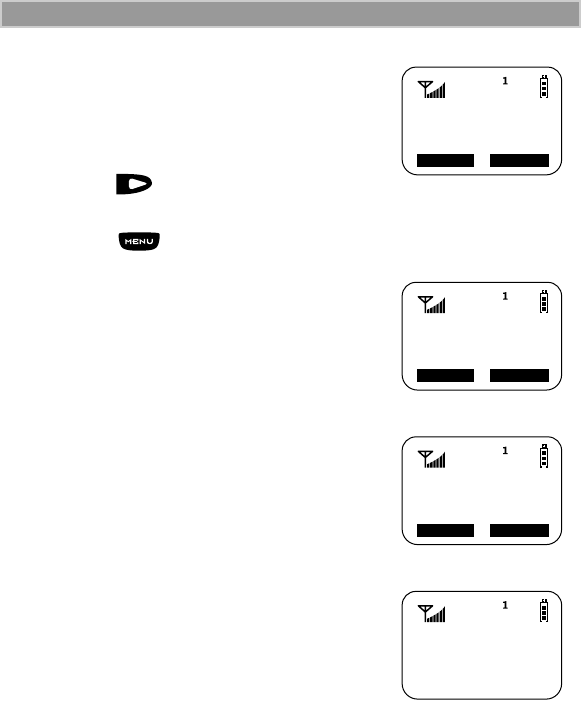
38
i2000 UserÕs Guide
To use Phone Number Quickstore, from either
the Phone Ready screen or from the Last 10
Calls Received or Sent List:
1. Do one of the following:
• To go to the last call that you dialed,
press .
• To view the Received and Sent Calls list,
press until you see “Calls”, then select it.
2. Select “Store”. The Enter Name screen
displays.
3. Enter the name then select “Store”.
The combined name and number entry is
stored in the first available storage space.
The Stored message displays with the name
that you stored.
Phone Ready
(System Name)
Name Mail
12:43p 11:35a
Phone Ready
0=5554455
Cancl Store
Enter Name
_
Cancl Store
JOHN
5551212
Stored
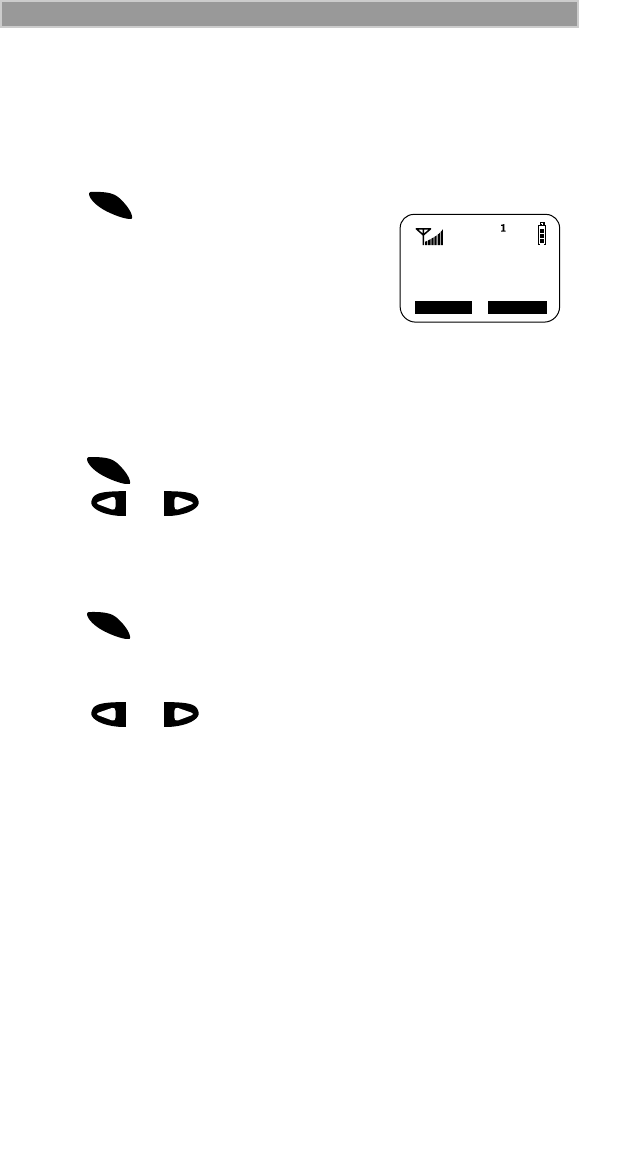
39
Making Private Calls
MAKING PRIVATE CALLS
A Private call is a one-to-one conversation between two people. In
Private mode, each
i
2000 is identified by a name or a number called a
Private ID.
To make a Private Call:
1. Press until you see “Prvt Ready”
on your display.
2. Use the keypad to enter the Private ID of
the person that you want to reach.
3. To speak, press and hold the PTT button,
wait for the chirp, then speak into the
microphone.
4. To listen, release the PTT button.
To use Scroll or Name Search, you must have a Private ID list.
Scroll
1. Press until you see “Prvt Ready” on your display.
2. Press or to scroll through the stored Private ID list.
3. Press and hold the PTT button, wait for the chirp, then speak into
the microphone.
Name Search
1. Press until you see “Prvt Ready” on your display.
2. Select “Name”.
3. Press the key with the first letter of the name you are searching for.
4. Press or to scroll through other stored names
associated with the letter you entered.
5. Press and hold the PTT button, wait for the chirp, then speak into
the microphone.
Prvt Ready
JOHN SMITH
Alert Name
o
d
e
M
o
d
e
M
o
d
e
M
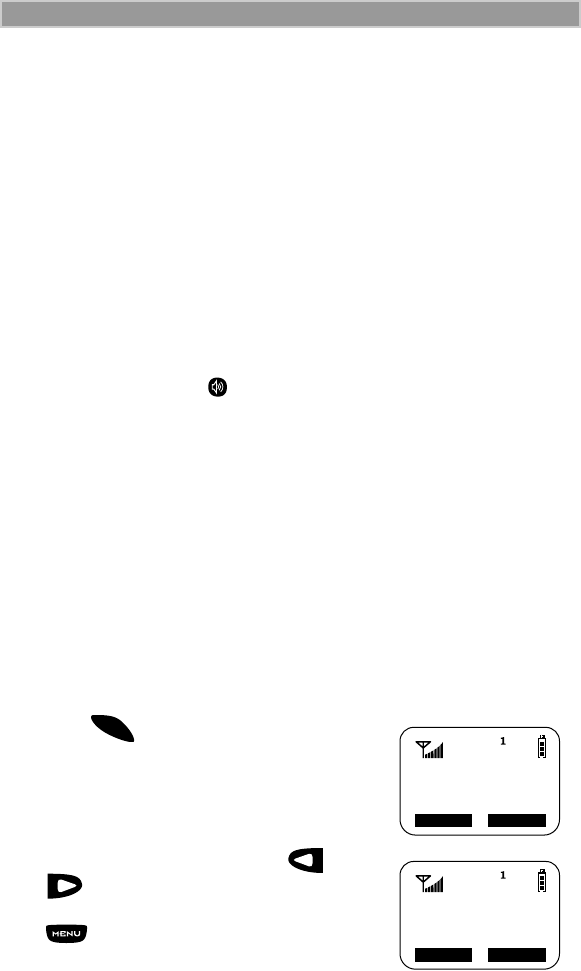
40
i2000 UserÕs Guide
Receiving a Private Call
When you receive an incoming Private call, you hear a brief chirp-like
tone. Your
i
2000 automatically switches to Private mode, and the Private
ID or the name of the caller displays.
1. Your phone must be idle, that is, not busy in an active call or on
the browser.
2. Wait for the caller to finish speaking.
3. Press and hold the PTT button. Begin speaking after you hear the
chirp.
Private/Group Mode Speaker
You can hear Private calls through either the earpiece or the speaker.
Press the Speaker button on your
i
2000 to turn the Private/Group
Mode Speaker on or off.
• With the Speaker on, you will hear incoming calls through the
speaker.
• With the Speaker off, you will hear incoming calls through the
earpiece.
Call Alert™
Call Alert enables you to page an individual by sending an audible tone.
A Call Alert allows the individual to respond when it is convenient. The
alert plays intermittently until the individual clears it.
Sending a Call Alert
1. Press to go to the “Prvt Ready”
screen.
2. Select “Alert”.
3. Enter the Private ID, or press or
to scroll to the desired name. You
may also select the name by pressing
and using Name Search.
4. Press the PTT button.
Prvt Ready
JOHN
Alert Name
o
d
e
M
Alert
JOHN
Exit Queue
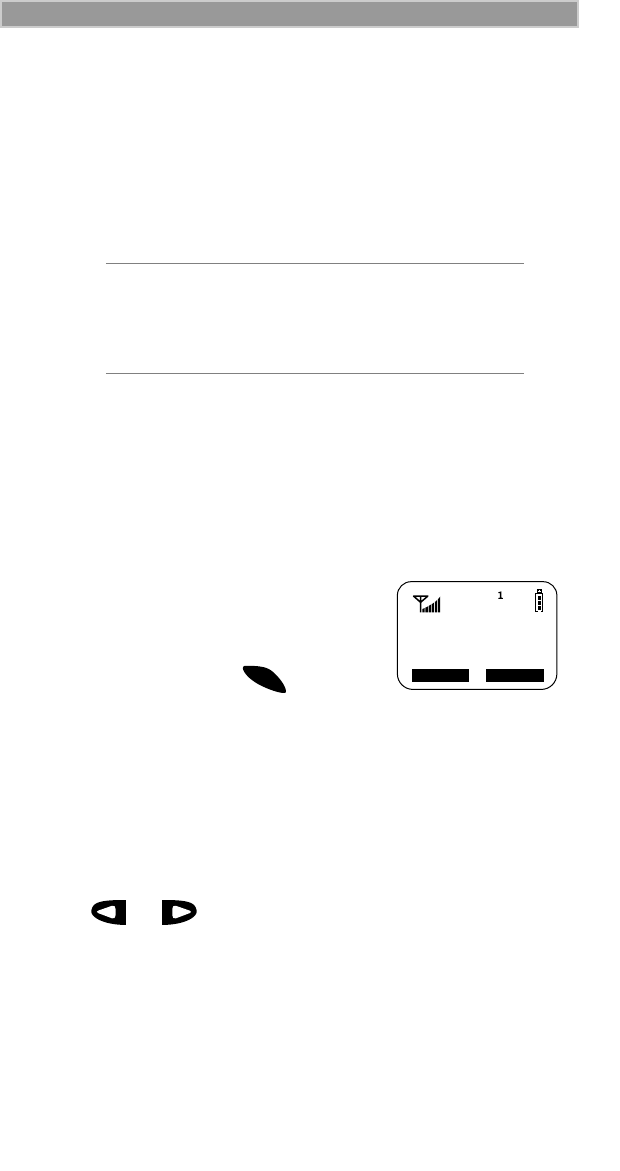
41
Making Private Calls
Receiving a Call Alert
When you receive a Call Alert, you will hear an alert tone and see a
message on your display.
• To answer the Call Alert, press the PTT button.
• To clear the Call Alert without answering it, select “Clear”.
• To silence the Call Alert without clearing it, press any key other
than the PTT button.
Call Alert Queuing
If you carrier provides Call Alert Queuing, you can save up to eight Call
Alerts in a queue for later use.
After you respond to the Call Alert, it is removed from the queue.
Clearing or Queueing a Call Alert
When you receive a Call Alert, do one of the
following:
• To clear a Call Alert, select “Clear”.
• To place the Call Alert into the queue,
select “Queue”. Pressing also
queues the Call Alert.
If you receive multiple Call Alerts, the last received Call Alert displays
and the remaining Call Alerts are stacked at the beginning of the queue.
Responding to a Queued Call Alert
You can respond to the Call Alerts in any order. To select a Call Alert for
response:
1. Select “Queue”.
2. Press or to scroll to the desired Call Alert.
3. Press the PTT button to respond to the Call Alert.
Quickstore of Private IDs
Quickstore allows you to quickly store a Private ID without having to
enter the programming menu.
NOTE
Until the Call Alert is cleared or returned, the alert
plays intermittently and you will not be able to
receive any additional Phone, Private, Group, or
Net calls.
Alert 3
JOHN SMITH
Clear Queue
o
d
e
M
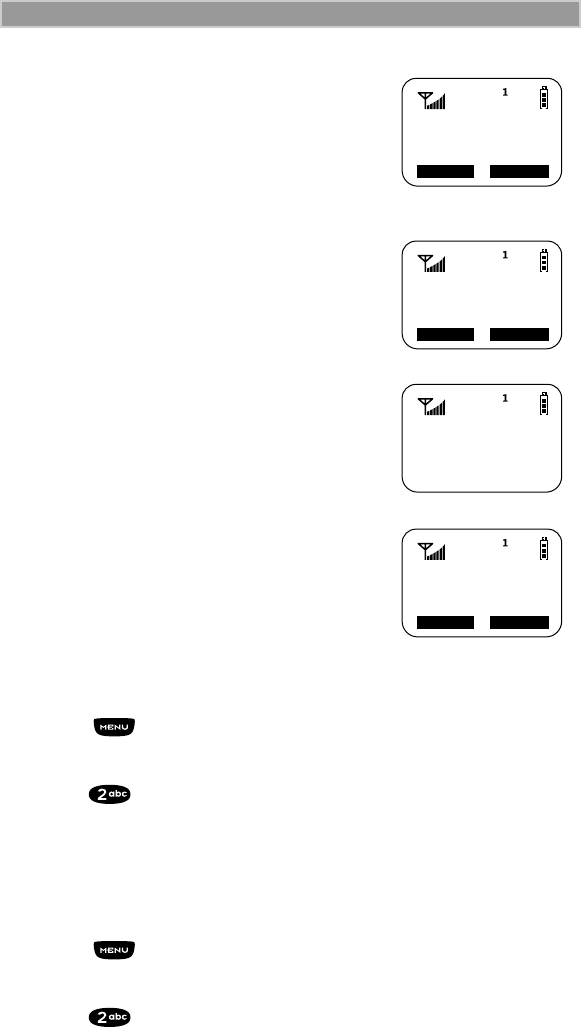
42
i2000 UserÕs Guide
From the Private Ready screen with the
Private ID displayed:
1. Select “Store”.
If an ID is greater than 12 characters,
the ID wraps to the third line, replacing
the time and date.
2. Enter the name associated with the
Private ID.
3. Select “Store”. The Stored message
displays.
If the list is full with the maximum 100
names, you will get the message, “Prvt
List Full”. You cannot add names until
you remove some names from the list.
4. Next, the Prvt Ready screen displays the
stored name.
Storing Your Private ID
To store your Private ID in your
i
2000:
1. Press until you see the “Prgm” menu selection.
2. Select “Prgm”.
3. Press . The screen displays the message, “2=Own Pvt ID”.
4. Select “Ok”.
5. Enter the Private ID provided by your carrier.
6. Select “Store”.
To view your private ID at any time after you store it:
1. Press until you see the “Prgm” menu selection.
2. Select “Prgm”.
3. Press . The screen displays the message, “2=Own Pvt ID”.
The next line displays your Private ID.
This is the number
supplied by your carrier that you store in your phone.
4. Select “Exit”.
Prvt Ready
56781
Alert Store
12:43p 10/18
Enter Name
_
Cancl Store
JOHN
Stored
Prvt Ready
JOHN
Alert Name
12:45p 10/18
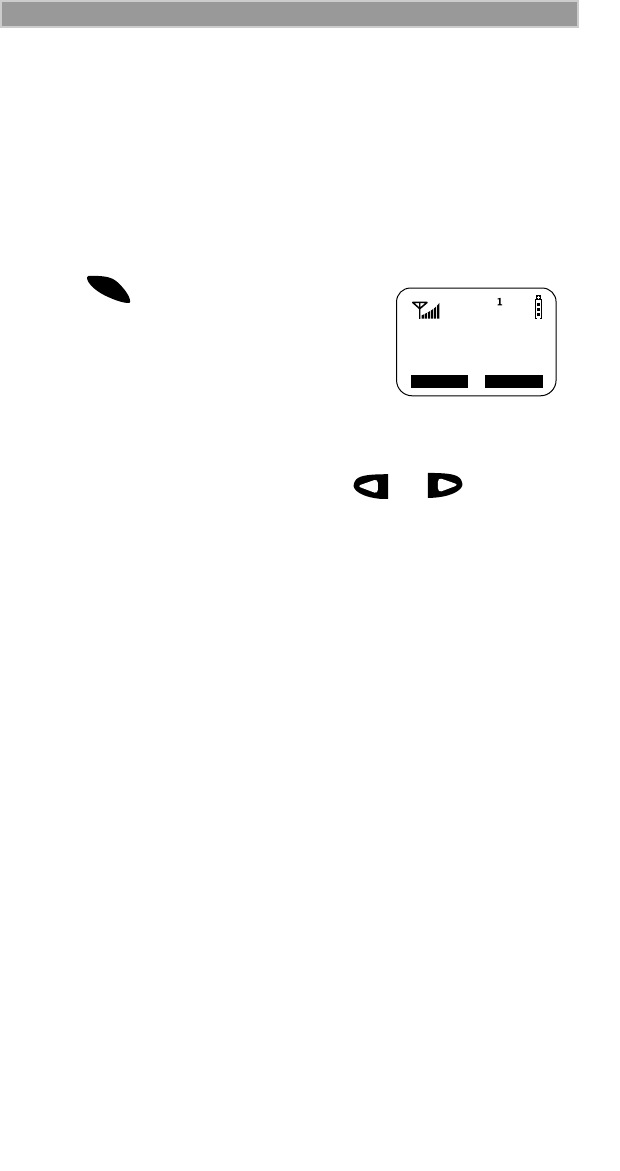
43
Making Group Calls (Iden only)
MAKING GROUP CALLS (IDEN
ONLY)
A Group Call allows you to communicate instantly with members of a
selected Talkgroup–a pre-defined set of people who share a
communication need.
Talkgroups appear on your display as numbers or programmed names,
such as Talkgrp10 or Sales Team.
To make a Group Call:
1. Press until “Group Ready”
displays. Your most recently used
talkgroup displays, for example,
“Talkgrp 10”.
2. To place a call, do one of the following:
• To speak to this talkgroup, press and
hold the PTT button. Wait for the
chirp, then speak into the microphone.
• To speak to another talkgroup, press or until you see
the desired talkgroup name. Press and hold the PTT button.Wait
for the chirp, then speak into the microphone.
3. To listen, release the PTT button.
Receiving a Group Call
When you receive an incoming Group call, you will hear a brief chirp-
like tone. Your
i
2000 automatically switches to Group mode, and the
Talkgroup name displays.
1. Your phone must be idle, that is, not busy in an active call or on
the browser.
2. Wait for the caller to finish speaking, then press and hold the PTT
button. Begin speaking after you hear the chirp.
3. To listen, release the PTT button.
You can receive group calls only in the Talkgroups that you have
predefined.
For more information, see “Adding or Storing a Talkgroup”
on page 44.
Group Ready
Talkgrp 10
Alert Mail
o
d
e
M
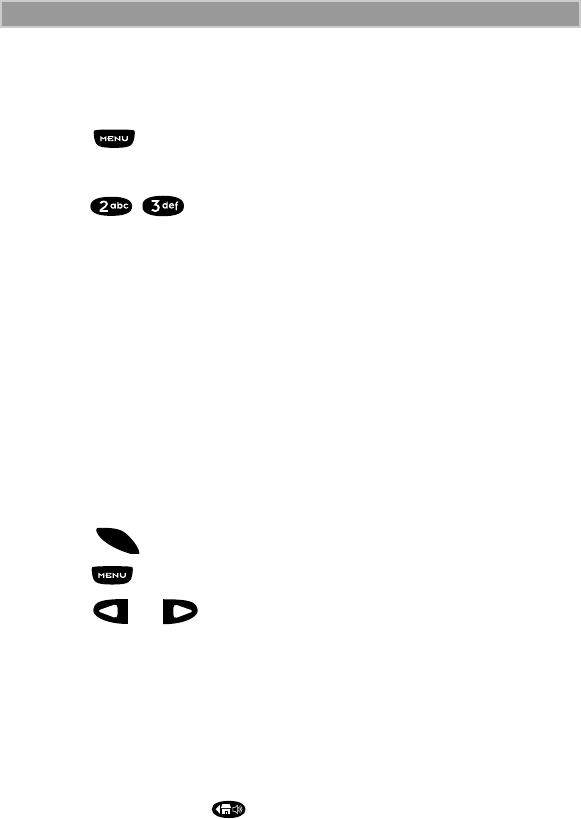
44
i2000 UserÕs Guide
Adding and Storing a Talkgroup
To add and store a talkgroup name to your i2000:
1. Press until you see the “Prgm” menu selection.
2. Select “Prgm”.
3. Press , .
4. Select “Ok”.
5. At “Add New Entry?”, select “Ok”.
6. At “Enter ID”, enter the desired talkgroup number and select
“Store”.
7. At “Enter Name”, enter a name for the talkgroup and select
“Store”.
Area Selection
In Group mode, you can call only those talkgroup members in a specific
location. This is useful when you know where the individuals are
located within the service area.
1. Press until you see “Group Ready” on your display.
2. Press , then select “Area”.
3. Press or to scroll through the targeted areas specified
by your local carrier.
4. Select “Ok” to select the targeted area.
Private/Group Mode Speaker
You can hear Group calls through either the earpiece or the speaker.
Press the Speaker button on the i2000 to turn the Private/Group
Mode Speaker on or off.
With the Speaker on, you will hear incoming calls through the speaker.
This is useful to monitor talkgroup activity in Group mode.
With the Speaker off, you will hear incoming calls through the earpiece.
o
d
e
M
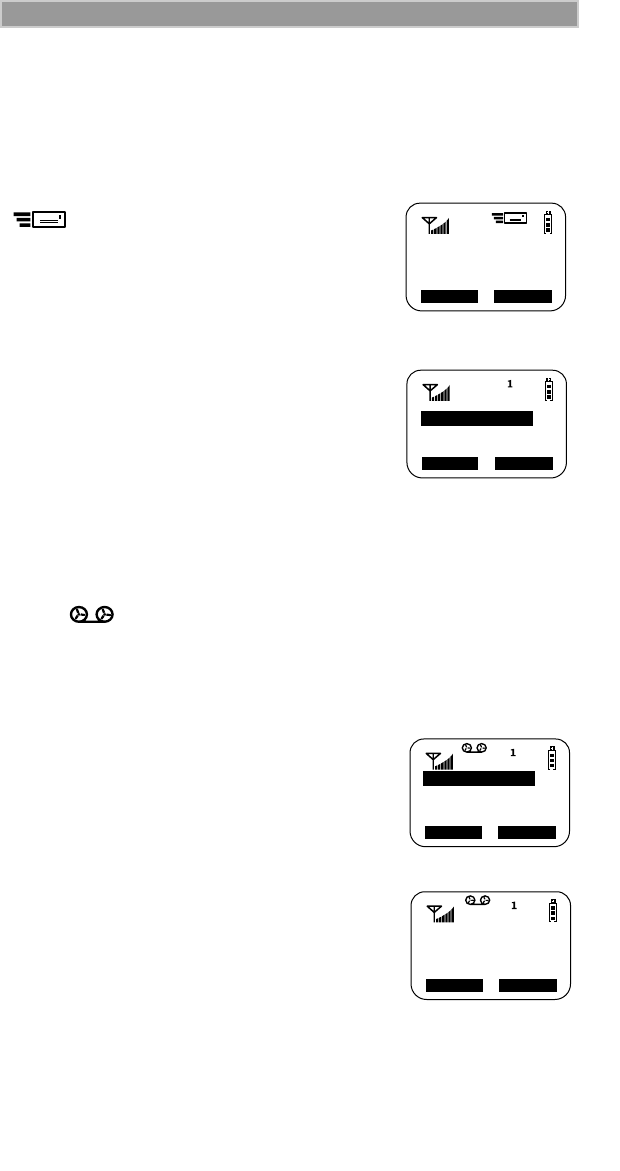
45
Using Mail Services
USING MAIL SERVICES
Your i2000 provides the following mail services:
¥ Voice Mail
¥ Message Mail
When you receive a new message, the
icon appears and flashes.
• To read your new mail immediately, select
“Now”.
• To read your new mail later, select “Later”.
An asterisk * next to a mail service indicates
new mail.
To use message services, select “Mail” from
any Ready screen. The inbox screen opens
with your message services listed.
To select a message service, scroll to highlight
the service or press the corresponding number.
For example, to access your Message Mail,
press 2.
Voice Mail
When your i2000 receives a Voice Mail message:
• The icon appears on your display.
• The Voice Mail alert tone sounds (if Mail Notification is turned on).
• The message, “New Voice Mail Waiting” appears on your display.
• An exclamation point (!) on the display indicates that you have at
least one urgent message.
From any mode:
1. Select “Mail”.
2. Select “VoiceMail”.
The VoiceMail inbox opens and displays the
number of your new and total VoiceMail
messages.
To retrieve your voice mail immediately:
1. Select “Dial”. This action automatically
places a call to your voice mailbox. The
most recent message is retrieved first.
2. To close your voice mailbox, select “Exit”.
New Mail
Later Now
Read?
1>VoiceMail
2>Mesg Mail
*
Exit Ok
2>Mesg Mail
1
>Vo
i
ceMa
il
Exit Ok
Exit Dial
Voice Mail
1 New
1 Total
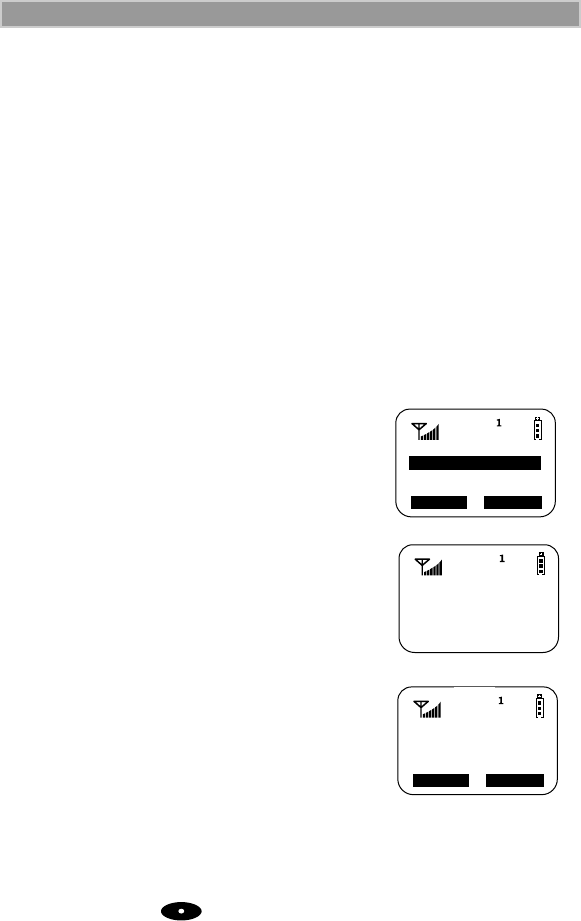
46
i2000 UserÕs Guide
Message Mail
Message Mail can be either a numeric page or a text message of up to
140 characters. Your phone can receive and store 16 mail messages at
any time.
1. To postpone reading your mail and to clear the display, select
“Later”. The icon stops flashing but remains on your display to
remind you that you have unread messages.
To read your mail now:
2. To read your mail now, select “Now”. The screen will briefly
display the number of new and saved messages in your mailbox.
3. A list of all your messages will be displayed. Highlight the
message that you wish to read and select “Read”.
To read your mail later:
4. From any mode, select “Mail”. The
Mail box opens.
5. Select “Mesg Mail”.
Your Message mailbox opens and briefly
displays the number of new and saved
messages currently in your mailbox.
6. Next, a list of all messages will display.
Select the message that you wish to
read and select “Read”.
Your message shows the time and date that
the sender entered it in the network.
Saving and Erasing Mail
After you read a text or numeric message, you can either Save or Erase
the message. Press under the desired option.
3> Net Mail
Exit Ok
1 Voice Mail
2
> Mes
g
Ma
il
>
*
Message Mail
2 New
0 Saved
*1>FR: Smith
11:15a 04/02
Exit Read
*2>FR: Jones

47
Using Mail Services
Auto Call Back
You can respond to numeric pages and text messages containing a call-
back number. To automatically dial a number contained within a
Message Mail, press .
Mail Memory Full
If all 16 message registers are full, your phone displays the message
“Mail Waiting, Memory Full”. You cannot receive new Message Mail
until you empty register space by erasing saved or unread messages.
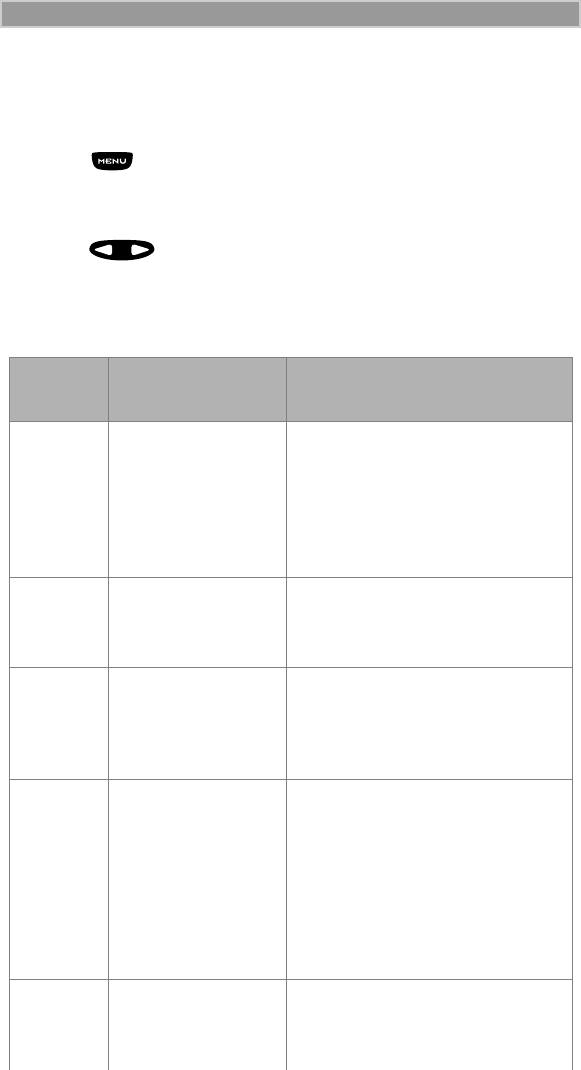
48
i2000 UserÕs Guide
SETTING PROGRAMMING MENUS
You can customize the settings on your phone using the Programming
Menu.
1. Press until you see “Prgm” on the display.
2. Select “Prgm”.
3. Select “Ok”.
4. Press to scroll to the desired Programming Menu Option
or enter the number of the Option.
Table 5: Programming Menu Options
Keypad
Number Menu Option Function
1 Own Ph # Automatically store the
telephone number of your
phone after you receive the first
incoming call (Line1). You can
also enter the number and view
it.
2 Own Pvt ID Display the private number of
your phone. You must first store
this number.
3 Mail Display:Off Turn on and off the New Mail
message that is displayed with
incoming Voice, Message, or
Net Mail.
4 Manual Lock:Off Lock your phone to prevent
unauthorized use. You must
enter a pass code to unlock it.
Even with the manual lock on,
you can reach emergency help
by pressing and holding the
emergency key designated by
your carrier.
5 Auto Lock:Off Automatically lock your phone
each time it is powered off to
prevent unauthorized use.
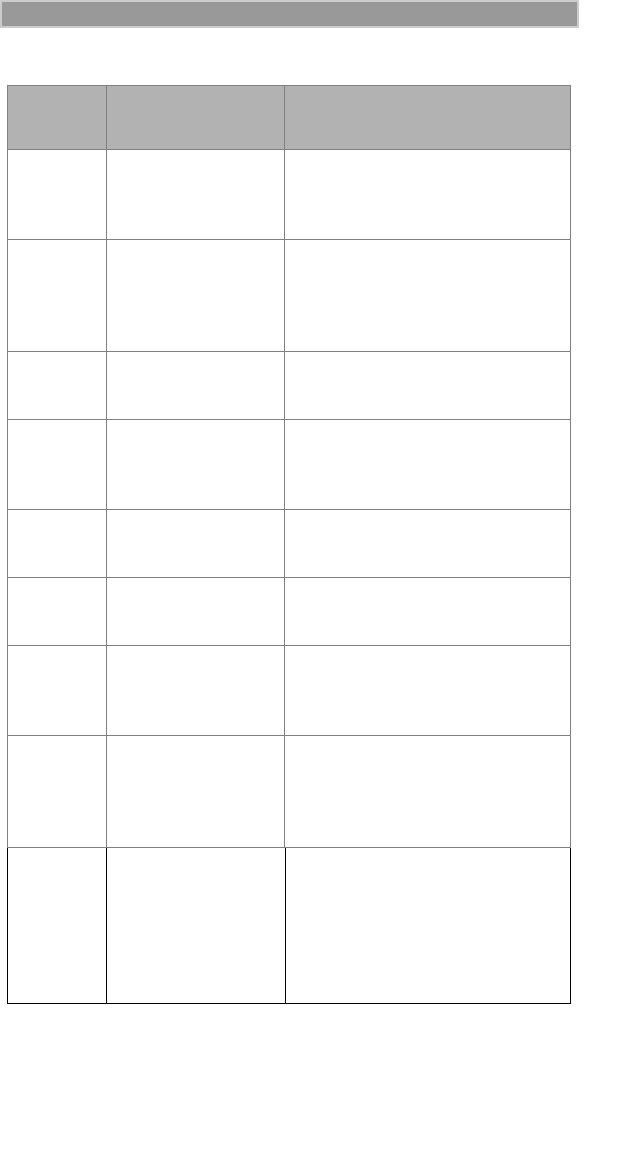
49
Setting Programming Menus
6 Auto Answer:Off Turn on or off automatic
answering of incoming phone
calls after 1-4 rings.
9 Vibrate Alert:Off Receive a non-audible alert for
incoming phone and circuit
data calls and messages. See
“VibraCall™” on page 19.
10 Last Call Timer Display the duration of the most
recent phone call.
11 Display Timer:Off Turn on or off automatic display
of the Last Call Timer at the
end of each phone call.
12 Reset Timer Display cumulative airtime of all
phone calls since last reset.
13 Total Timer Display cumulative airtime of all
phone calls.
14 1 Minute Beep:Off Automatically signal each
minute of elapsed phone
airtime with an audible beep.
20 Phone/Prvt List Add phone and private
numbers in one procedure. See
“Combined Phone Number and
Private ID List” on page 33.
21 Phone List Edit Edit and erase up to 100
frequently called phone
numbers and associated
names. See “Editing and
Erasing Phone List Entries” on
page 35.
Table 5: Programming Menu Options (Continued)
Keypad
Number Menu Option Function
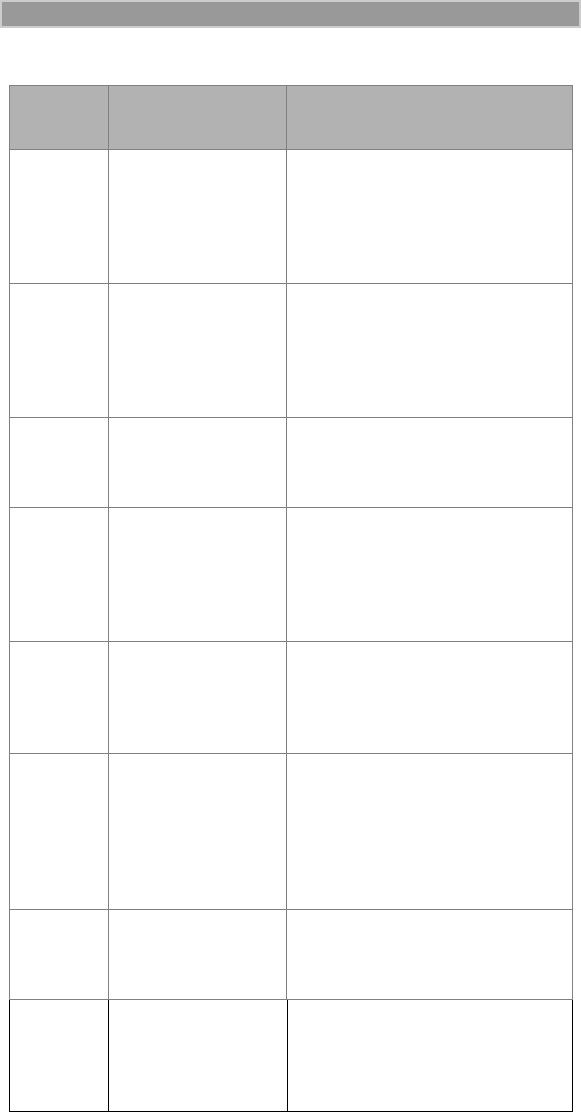
50
i2000 UserÕs Guide
22 Prvt ID List Edit Edit and erase up to 100
Private numbers and
associated names. See
“Editing and Erasing Private ID
List Entries” on page 36.
23 Talkgrp List
Program Add/Edit/Erase numbers and
associated names for up to 10
pre-programmed talkgroups.
See “Adding and Storing a
Talkgroup” on page 44.
24 Area List Program Add/Edit/Erase numbers and
associated names for up to 50
targeted areas.
30 Ringer Volume Set the ringer volume using the
volume control keys, or lower
the volume to silence the
ringer. See “Setting the Ringer
Volume” on page 21.
31 Set Ring Style Select a distinct ring style for
incoming phone calls. See
“Selecting a Ring Style” on
page 21.
32 Mail Volume Set the volume of incoming
Message Mail, Voice Mail, and
Net alert tones using the
volume control keys, or lower
the volume to silence the mail
alert tones.
33 Earpiece Volume Set the default earpiece
volume using the volume
control keys.
34 Keypad Volume Set the volume of the keypad
tones using the volume control
keys, or to silence the keypad
tones.
Table 5: Programming Menu Options (Continued)
Keypad
Number Menu Option Function
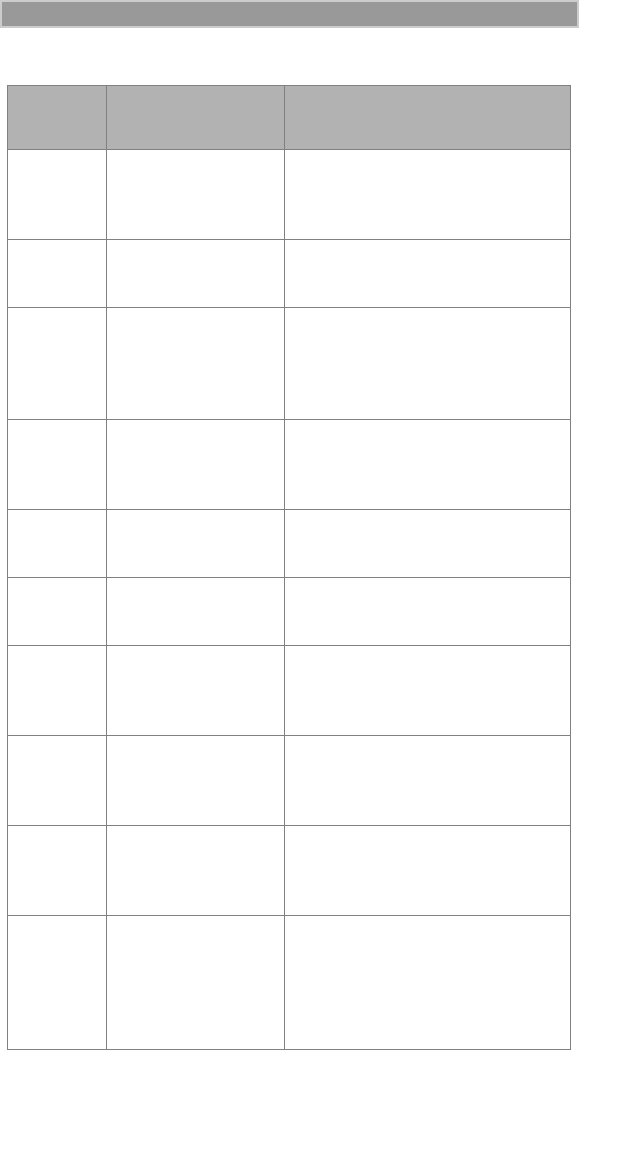
51
Setting Programming Menus
35 Speaker Volume Temporarily adjust the Group/
Private Speaker volume for
noisy environments.
36 Spkr Vol Set Tone Turn the speaker volume set
tones on or off.
38 Silent Group Silence all incoming Group call
alerts and voice activity. When
set, your screen displays the
message, Group Silent.
40 Change Passcode Change your secret four-digit
passcode from the initial
setting 0000.
46 Change SIM Card
PINs Change your personal SIM
card PIN.
47 Require SIM Card
PIN Set or remove PIN requirement
when you turn on your
i
2000.
55 Phone Sysl Set your
i
2000 for travel by
choosing a phone system
setting.
57 GSM Network
Search Automatically or manually
search for an available
network.
(GSM only)
58 GSM Network List
Program Add, edit, or erase entries in
your preferred list. View entries
from the known list.
(GSM only)
70 Language Select one of four languages
for your display text.
The
default is English.
See
“Changing the Display
Language” on page 13.
Table 5: Programming Menu Options (Continued)
Keypad
Number Menu Option Function
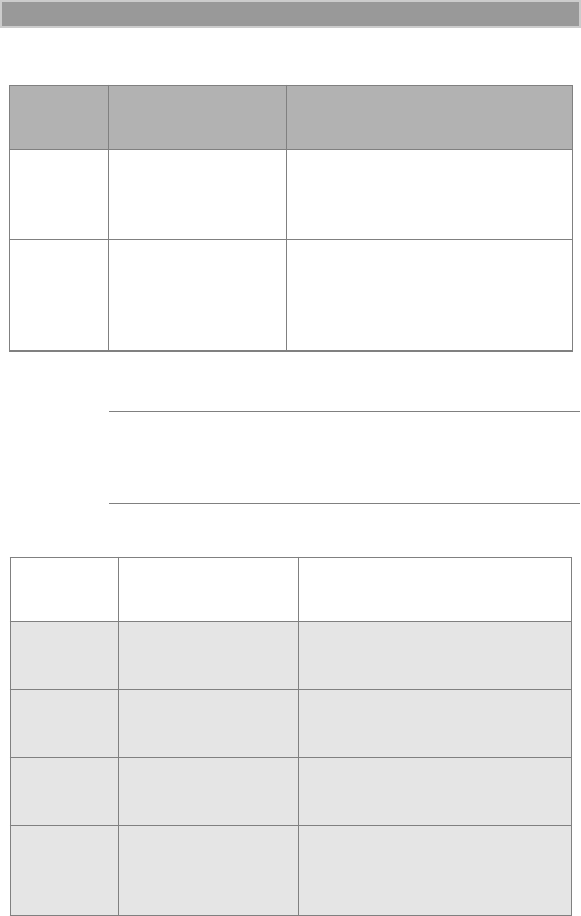
52
i2000 UserÕs Guide
71 Time/Date Select the format for the time
and date display. See “Setting
the Time and Date” on page 12.
80 Phone Only Turn on or off incoming Private,
Group, and Browser data
services. See “Phone Only
Mode (iDEN Only)” on page 29.
NOTE Important! Do not perform the following shaded menu
options unless you are instructed to do so by your
carrier. You could damage your phone.
Table 6: Other Programming Menu Options
Option
Number Menu Option Function
41 Feature Reset Returns all feature settings to
their original defaults.
42 Master Clear Performs Feature Reset and
erases all stored lists.
43 Master Reset Resets the phone’s
identification number.
51 Network ID Edits the pre-programmed
Network number list and
selects roaming options.
Table 5: Programming Menu Options (Continued)
Keypad
Number Menu Option Function
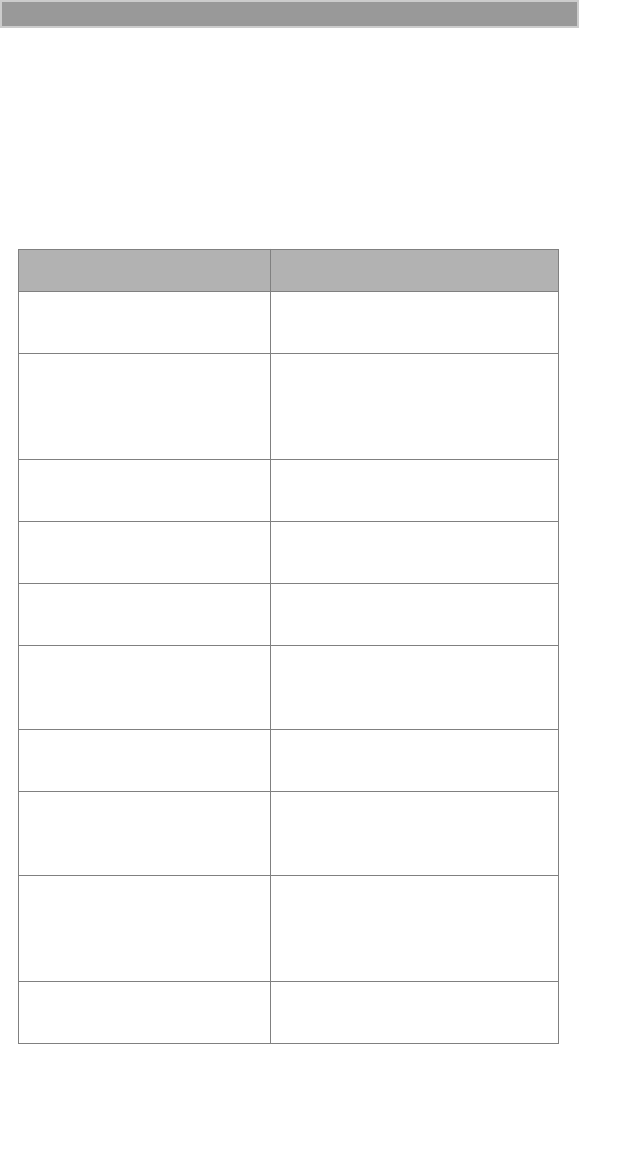
53
About Status Messages
ABOUT STATUS MESSAGES
You may receive status messages under certain conditions. Before
contacting your carrier, note the message, numeric code, and the
conditions under which it appeared. Table 7 lists and describes the error
messages.
Table 7: Status Messages
Status Messages Message Description
Number Not in Service The number that you entered is
not valid.
User Not Available The party that you called is
either busy, out-of-range, or
turned off. Please try again
later.
User Not Authorized The party that you called has
not purchased this service.
Please Try Later This service is temporarily not
available. Please try again later.
User Busy in Private The party that you called is
busy in a Private call.
Service Restricted This service was restricted by
your carrier or it was not
purchased.
Service Not Available This feature is not available on
the current network.
System Busy Try Later The system is experiencing
heavy traffic. Please try again
later.
Service Conflict This service cannot be enabled
because an incompatible
service has already been
turned on.
Please Try Again An error occurred. Note the
error code and try again.
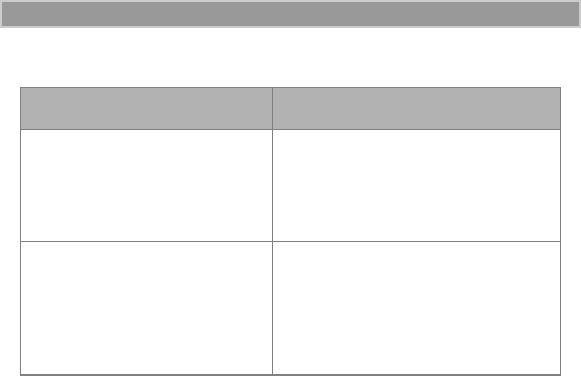
54
i2000 UserÕs Guide
Self Check Error A fault was detected with your
phone. If this error recurs, note
the error code and contact your
carrier.
Self Check Fail An operational fault was
detected with your phone. Note
the numeric code, turn your
phone off, and contact your
carrier immediately.
Table 7: Status Messages (Continued)
Status Messages Message Description
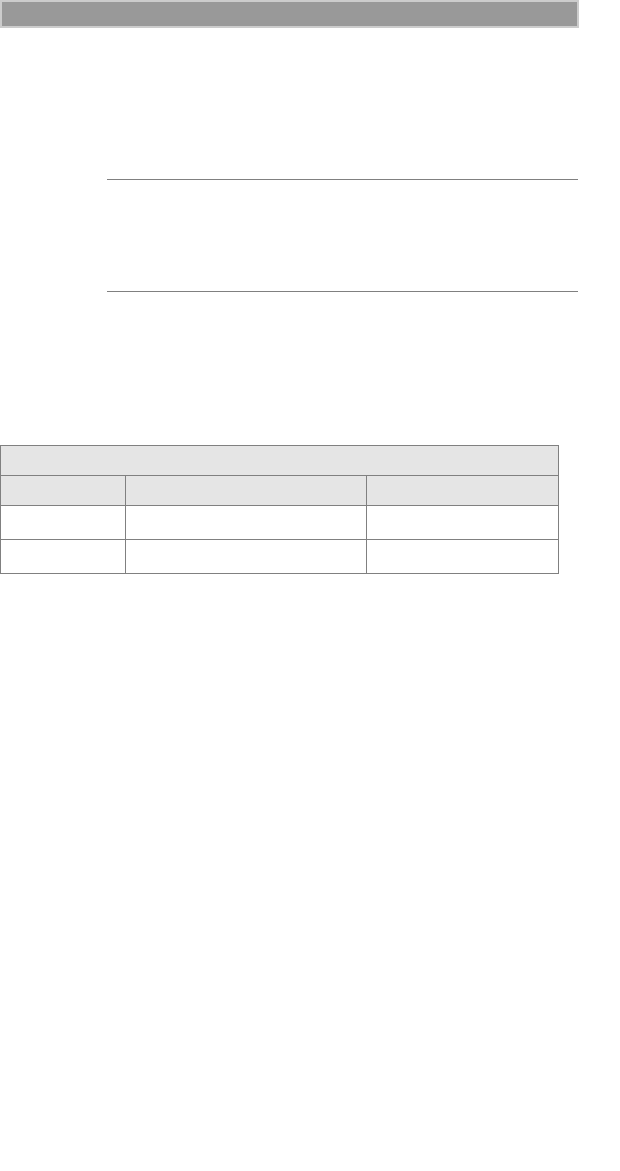
55
Accessories
ACCESSORIES
Batteries
Charging the Batteries
Table 8 provides the approximate time to fully charge a battery using a
Motorola iDEN-Approved Lithium Ion battery charger.
Table 8: Battery Charging Times
* Charging times are based on a fully discharged battery.
For optimal battery life, use a Motorola iDEN Approved Lithium Ion
charger with your Motorola iDEN Lithium Ion battery. Other chargers
may not fully charge your Lithium Ion battery or may yield a reduced
number of cycles.
Battery Operating Instructions
• Extreme temperatures will degrade battery performance. Do not
store your battery where temperatures exceed 60°C (140°F) or fall
below -20°C (4°F).
• This Lithium Ion battery has a self discharge rate and without use,
will lose about 1% of its charge per day.
• The battery capacity will be degraded if stored for long periods while
fully charged. If long term storage is required, store at half capacity.
• The Motorola iDEN Approved Lithium Ion chargers will provide
optimum performance. Other chargers may not fully charge your
iDEN Lithium Ion battery or may yield reduced number of charge
cycles.
• If the battery appears inoperative, the internal protection circuitry
may have been activated. Remove the battery from the phone and put
it into the charger for several minutes to reset the circuitry.
• When the battery is not in use, always store it in the safety tray.
NOTE • For best results, charge the batteries within the
temperature range of 10oC to 40oC (50oF to 104oF).
• Prolonged charging is not recommended. See Table 8
for battery charging guidelines.
MOTOROLA BATTERIES
Kit Number Description/Chemistry Charging Time*
NTN8615 Slim Lithium Ion 2.5 Hours
NTN8614 Standard Lithium Ion 3 Hours
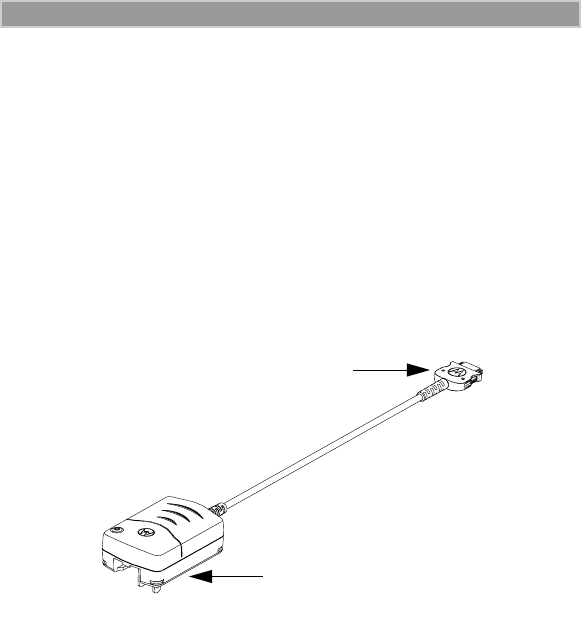
56
i2000 UserÕs Guide
Travel Charger
Using the NPN6197 Travel Charger, you can charge a battery from an
AC outlet. On one end of the travel charger, an accessory connector
attaches to the bottom of the phone unit. At the other (AC outlet) end of
the device, there is a compact housing that contains the plug-in power
supply. A lightweight cable connects the two ends (accessory connector
and supply).
A green LED on the accessory power supply indicates that the Travel
Charger is plugged in.
Using the Travel Charger
Figure 3. Using the Travel Charger
1. While holding the i2000 with its front toward you, insert the
accessory connector (with the Motorola logo facing you) into the
slot on the bottom of the i2000 until you hear a click.
2. Plug the Travel Charger transformer into an AC wall outlet. The
power light (green LED) on the accessory power supply will
come on.
Travel Charger Operating Specifications
Input voltage range: 90-264 VAC @ 50/60 Hz.
Operating temperature range: 0°C to +50°C
Vehicular Battery Charger
The NTN8655 Vehicular Battery Charger (VBC) provides power to the
phone unit and charges the phone’s Lithium Ion battery.
The power light (green LED) will light when the VBC is receiving
power.
Travel Charger
Transformer
Accessory Connector
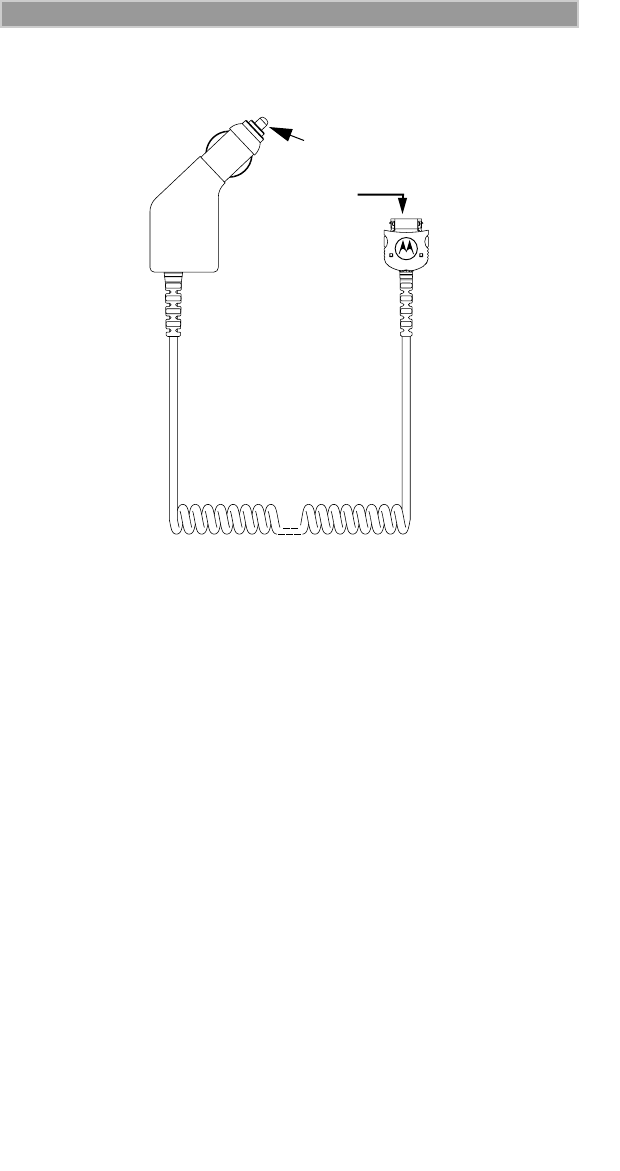
57
Accessories
Using the Vehicular Battery Charger
Figure 4. Using the Vehicular Battery Charger
1. Attach the Vehicular Battery Charger’s accessory connector to the
bottom of the i2000. While holding the i2000 with its front toward
you, insert the accessory connector (with the Motorola logo
facing you) into the slot on the bottom of the i2000 until you hear
a click.
2. Remove the vehicle’s cigarette lighter plug from the cigarette
lighter receptacle.
3. Plug the Vehicular Battery Charger’s cigarette lighter adapter into
the cigarette lighter receptacle. The power light (green LED) will
come on.
4. The i2000 may be turned off, turned on, or used.
Removing the Vehicular Battery Charger
1. Unplug the Vehicular Battery Charger’s cigarette lighter adapter
from the vehicle’s cigarette lighter receptacle.
2. Press the latches on the accessory connector.
3. Pull the accessory connector from the bottom of the i2000.
Vehicular Battery Charger Operating Specifications
Operating voltage range: 10.8 - 33.0 Vdc.
Operating temperature range: -30°C to +60°C
Cigarette Lighter
Adapter
Accessory
Accessory
Connector
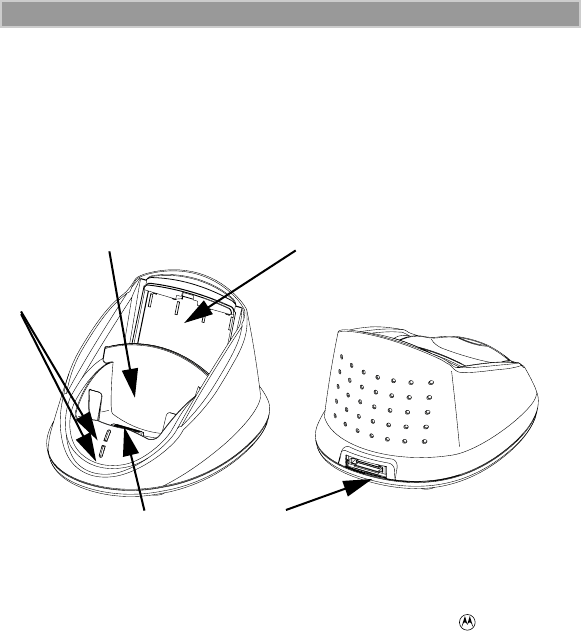
58
i2000 UserÕs Guide
Desktop Dual-Pocket Charger
The NTN8968 Desktop Dual-Pocket Charger charges Motorola
authorized batteries, as listed on page 55, for the i2000. To charge a
battery, see Figure 5.
Charging a Battery
Figure 5. Desktop Dual-Pocket Charger
1. Plug the flat end of the power-supply cord, with the logo facing
down, into the receptacle labeled “Charging” on the back of the
charger.
2. Plug the transformer end of the power-supply cord into any
standard AC wall outlet.
3. Insert an i2000 with an attached battery, into the charger's front
pocket. This is done by inserting the bottom of the i2000 onto the
pin connector in the bottom of the charger's front pocket.
Rear PocketFront Pocket
Pin Connector Power supply cord receptacle
LED
Indicator
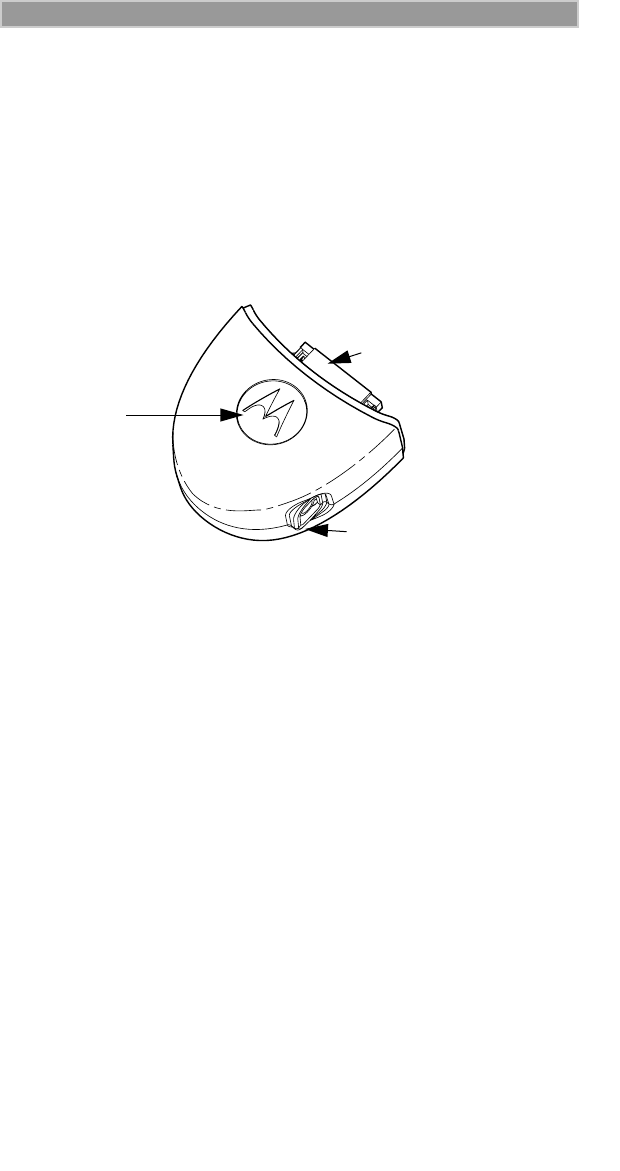
59
Accessories
Audio Adapter
The NTN8654 Audio Adapter connects an earpiece microphone to your
i2000 for privacy and hands-free operation.
The Audio Adapter fits onto the bottom of the i2000 and provides a
standard 2.5mm jack connection for an earpiece microphone
(NTN8367) or headset.
Using the Audio Adapter
Figure 6. Using the Audio Adapter
1. Hold the phone and the Audio Adapter facing you so that you see
the Motorola logo on the adapter.
2. Insert the Audio Adapter’s connector into the i2000 receptacle.
You will hear the connector snap into place.
Attaching/Detaching the Earpiece Microphone
1. Insert the 2.5mm plug of the earpiece microphone cord into the
jack of the Audio Adapter.
2. Pull on the plug, not the cord, to remove the earpiece microphone.
Removing the Audio Adapter
1. Press the button on the front of the Audio Adapter. The front
displays the Motorola logo on the button.
2. Pull the Audio Adapter from the i2000.
Audio Adapter
Connector
2.5mm jack
Button
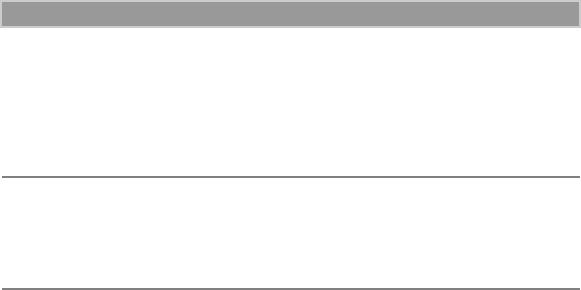
60
i2000 UserÕs Guide
For the Safe and Efficient Operation of Your Radio,
Observe these Guidelines:
Your radio product contains a transmitter and a receiver. When it is ON,
it receives and transmits radio frequency (RF) energy. The radio
operates in the frequency range of 806 MHz to 870 MHz or 890 MHz to
960 MHz, and employs digital modulation techniques. When you
communicate with your radio product, the system handling your call
controls the power level at which your radio product transmits. The
output power level typically may vary over a range from 0.00024
watts to 0.6 watts at, or below, 870 MHz, and 3.2 watts at, or above,
890 MHz.
Exposure To Radio Frequency Energy
Your Motorola Radio Product is designed to comply with the following
national and international standards and guidelines regarding exposure
of human beings to radio frequency electromagnetic energy:
• United States Federal Communications Commission, Code of
Federal Regulations; 47 CFR part 2 sub-part J
• American National Standards Institute (ANSI) IEEE. C95. 1-1992
• National Council on Radiation Protection and Measurements
(NCRP). Report 86
• International Commission on Non-Ionizing Radiation Protection
(ICNIRP) 1998
• National Radiological Protection Board of the United Kingdom,
GS 11, 1988
• Verband Deutscher Elektrotechniker (VDE) DIN-0848
• Department of Health and Welfare Canada. Safety Code 6
To assure optimal radio product performance and make sure human
exposure to radio frequency electromagnetic energy is within the
guidelines set forth in the above standards, always adhere to the
following procedures:
When placing or receiving a phone call, or using the group and private
call functions with a Group/Private Speaker OFF (muted speaker icon
SAFETY AND GENERAL
INFORMATION
IMPORTANT INFORMATION ON SAFE AND
EFFICIENT OPERATION.
READ THIS INFORMATION BEFORE USING YOUR
INTEGRATED MULTI-SERVICE PORTABLE RADIO.

61
Safety and General Information
visible in the display), hold your radio product as you would a
telephone. Speak directly into the microphone and position the antenna
up and over your shoulder.
When using your radio product as a traditional
two-way radio while making group or private calls
with the Group/Private Speaker ON (no speaker
icon visible in the display), hold the radio product
in a vertical position with the microphone one to
two inches (2.5 to 5 cm) away from the lips.
For body-worn operation, with or without an
earpiece or any other accessory, the antenna should
be kept at least one inch (2.5 cm) from the body
when transmitting. A carry holder with a belt clip is provided with the
radio product for body-worn use.
When using any data feature of the radio product, with or without an
accessory cable, position the antenna of the radio product at least one
inch (2.5 cm) away from the body.
DO NOT hold the antenna when the radio is “IN USE”. Holding the
antenna affects call quality and may cause the radio product to operate
at a higher power level than needed.
Interference to Medical and Personal Electronic Devices
Most electronic equipment is shielded from RF energy. However,
certain equipment may not be shielded against the RF signals from your
radio product.
Pacemakers
The Health Industry Manufacturers Association recommends that a
minimum separation of 6 inches (15 cm) be maintained between a
handheld wireless phone and a pacemaker to avoid potential
interference with the pacemaker. These recommendations are consistent
with the independent research by and recommendations of Wireless
Technology Research.
Persons with pacemakers should:
• ALWAYS keep the radio product more than six inches from the
pacemaker when the radio product is turned ON.
• Not carry the radio product in a breast pocket.
• Use the ear opposite the pacemaker to minimize the potential for
interference.
• Turn the radio product OFF immediately if you have any reason to
suspect that interference is taking place.
Hearing Aids
Some radio products may interfere with some hearing aids. In the event
of such interference, you may want to consult your hearing aid
manufacturer to discuss alternatives.

62
i2000 UserÕs Guide
Other Medical Devices
If you use any other personal medical device, consult the manufacturer
of your device to determine if it is adequately shielded from external RF
energy. Your physician may be able to assist you in obtaining this
information.
Turn your radio product OFF in health care facilities when any
regulations posted in these areas instruct you to do so. Hospitals or
health care facilities may be using equipment that could be sensitive to
external RF energy.
Interference to Other Electronic Devices
RF energy may affect improperly installed or inadequately shielded
electronic operating and entertainment systems in motor vehicles.
Check with the manufacturer or representative to determine if these
systems are adequately shielded from external RF energy. Also check
with the manufacturer of any equipment that has been added to the
vehicle.
Turn your radio product OFF before boarding any aircraft to prevent
possible interference to aircraft systems. Regulations of the United
States Federal Communications Commission prohibit use when the
plane is airborne. The United States Department of Transportation
regulations require you have permission from a crew member to use
your radio product while the plane is on the ground.
Safety and General
Use While Driving
Check the laws and regulations on the use of wireless telephones in the
area where you drive. Always obey them.
When using the radio product while driving, please:
• Give full attention to driving and to the road
• Use hands-free operation, if available
• Pull off the road and park before making or answering a call if
driving conditions so require.
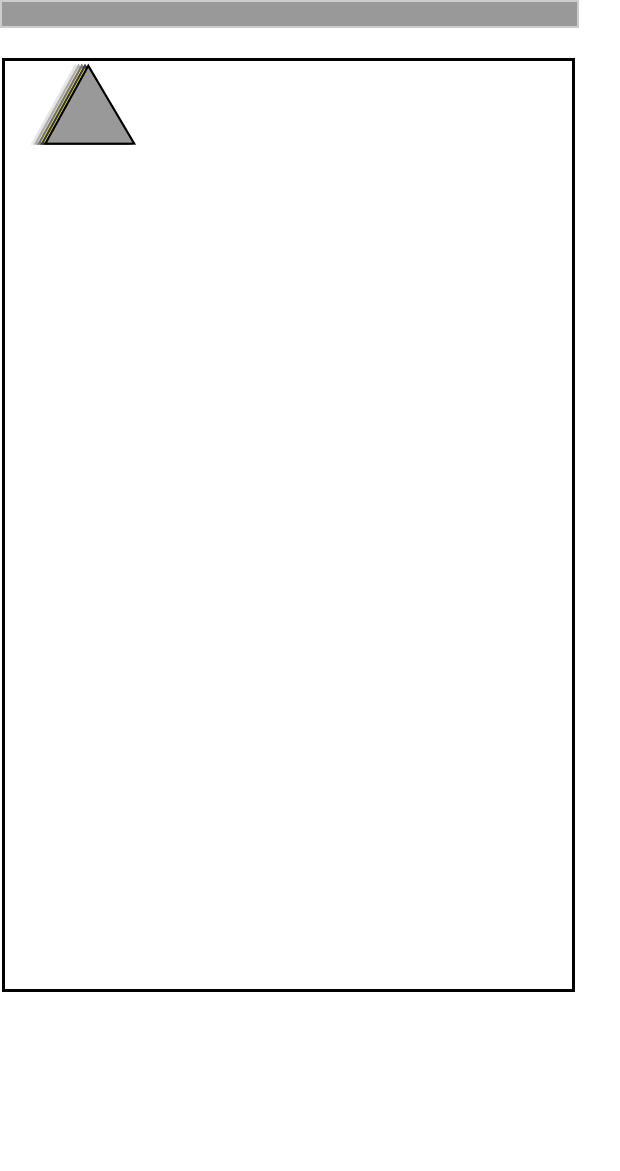
63
Safety and General Information
OPERATIONAL
WARNINGS
POTENTIALLY EXPLOSIVE ATMOSPHERES
Turn off your radio product when you are in any area with a
potentially explosive atmosphere, unless it is a radio product type
especially qualified for use in such areas (for example, Factory
Mutual Approved). Sparks in a potentially explosive atmosphere
can cause an explosion or fire resulting in bodily injury, or even
death.
Note: The areas with potentially explosive atmospheres referred to
above include fueling areas such as: below decks on boats; fuel or
chemical transfer or storage facilities; areas where the air contains
chemicals or particles such as grain, dust or metal powders; and
any other area where you would normally be advised to turn off
your vehicle engine. Areas with potentially explosive atmospheres
are often, but not always posted.
Batteries
Do not replace or charge batteries in a potentially explosive
atmosphere. Contact sparking may occur while installing or
removing batteries and cause an explosion.
BLASTING CAPS AND AREAS
To avoid possible interference with blasting operations, turn off
your radio product when you are near electrical blasting caps, in a
blasting area, or in areas posted: “Turn off two-way radio”. Obey all
signs and instructions.
FOR VEHICLES EQUIPPED WITH AN AIR BAG
Do NOT place objects, including both installed and portable
wireless equipment, in the area over the air bag or in the air bag
deployment area. An air bag inflates with great force. If in-vehicle
wireless equipment is improperly installed and the air bag inflates,
serious injury could result.
!
W A R N I N G
!
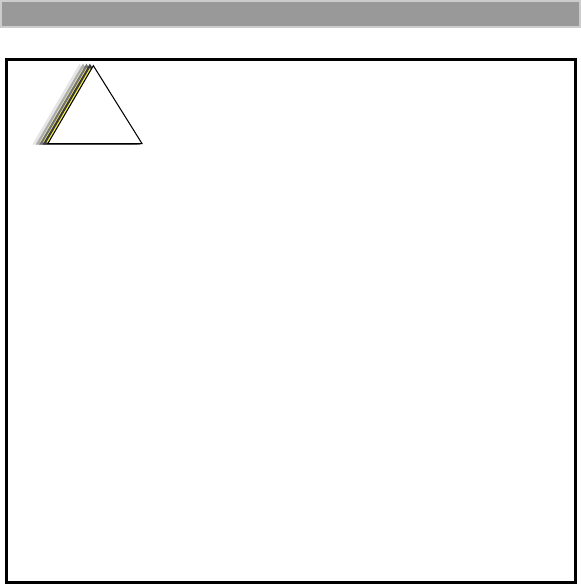
64
i2000 UserÕs Guide
Cleaning Instructions
Clean the external surfaces of the radio product with a damp cloth, using
a mild solution of dishwashing detergent and water. Some household
cleaners may contain chemicals that could seriously damage the radio
product. Avoid the use of any petroleum-based solvent cleaners. Also,
avoid applying liquids directly on the radio product.
Antenna Considerations
Use only the supplied or an approved antenna. Unauthorized antennas,
modifications, or attachments could impair call quality, damage the
radio product, or result in violation of local agency regulations.
OPERATIONAL
CAUTIONS
DAMAGED ANTENNAS
Do not use any portable radio product that has a damaged antenna.
If a damaged antenna comes into contact with your skin, a minor
burn can result.
BATTERIES
All batteries can cause property damage and/or bodily injury such
as burns if a conductive material such as jewelry, keys, or beaded
chains touch exposed terminals. The conductive material may
complete an electrical circuit (short circuit) and become quite hot.
Exercise care in handling any charged battery, particularly when
placing it inside a pocket, purse, or other container with metal
objects.
!
C a u t i o n
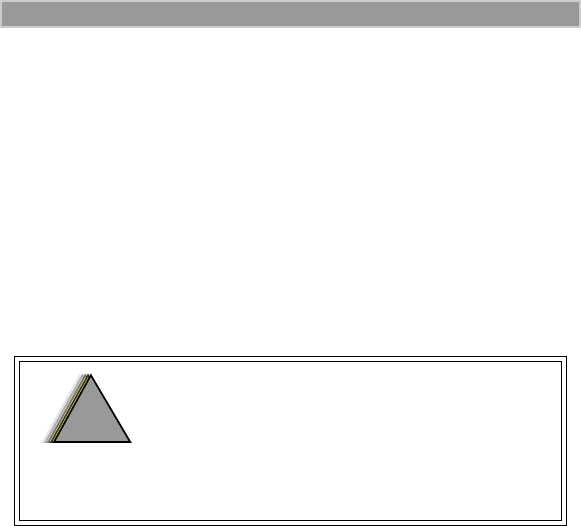
65
i2000 UserÕs Guide
Accessory Safety Information
IMPORTANT:
SAVE THESE ACCESSORY SAFETY INSTRUCTIONS
• Before using any battery or battery charger, read all the instructions
for and cautionary markings on (1) the battery, (2) the battery
charger, which may include a separate wall-mounted power supply
or transformer, and (3) the radio product using the battery.
• Do not expose any battery charger to water, rain, or snow as they
are designed for indoor or in-vehicle use only.
• Since a battery charger is designed for indoor or in-vehicle use
only, do not expose a battery charger to water, rain, or snow.
• To reduce the risk of damage to the cord or plug, pull by the plug
rather than the cord when you disconnect the battery charger from
the power source outlet.
• Do not operate any battery charger with a damaged cord or plug -
replace them immediately.
• Battery chargers may become warm during operation, but not hot.
If it becomes hot to the touch, unplug it from the power outlet
immediately and discontinue its use.
• Use of a non-recommended attachment to a battery charger may
result in a risk of fire, electric shock, or injury to persons.
• Make sure the battery charger power cord is located so that it will
not be stepped on, tripped over, or subjected to damage or stress.
• An extension cord should not be used with any battery charger
unless absolutely necessary. Use of an improper extension cord
could result in a risk of fire and electric shock. If an extension cord
must be used, make sure that:
❒The pins on the plug of the extension cord are the same
number, size, and shape as those on the plug of the
charger.
❒The extension cord is properly wired and in good
electrical condition.
❒The cord size is 18AWG for lengths up to 100 feet and
16AWG for lengths up to 150 feet.
To reduce the risk of injury, charge only the
rechargeable batteries listed in the
Accessories section of this manual. Other
types of batteries may burst, causing
personal injury and damage.
!
W A R N I N G
!

66
i2000 UserÕs Guide
• Do not operate any battery charger if it has received a sharp blow,
has been dropped, or has been damaged in any way; take it to a
qualified service technician.
• Do not disassemble a battery charger; take it to a qualified service
technician when service or repair is required. Incorrect reassembly
may result in a risk of electric shock or fire.
• Maximum ambient temperature around the power supply or
transformer of any battery charger should not exceed 40°C (104°F).
• The output power from the power supply or transformer must not
exceed the rating given on the Desktop Dual-Pocket Charger.
• The disconnection from the line voltage is made by unplugging the
power supply from the AC receptacle.
• To reduce risk of electric shock, unplug any battery charger from
the outlet before attempting any maintenance or cleaning.
• For optimum charging performance, turn off the radio product
while charging it in any battery charger.